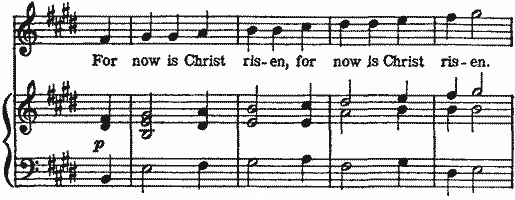
The Project Gutenberg EBook of Style in Singing, by W. E. Haslam This eBook is for the use of anyone anywhere at no cost and with almost no restrictions whatsoever. You may copy it, give it away or re-use it under the terms of the Project Gutenberg License included with this eBook or online at www.gutenberg.org Title: Style in Singing Author: W. E. Haslam Release Date: May 9, 2007 [EBook #21400] Language: English Character set encoding: ISO-8859-1 *** START OF THIS PROJECT GUTENBERG EBOOK STYLE IN SINGING *** Produced by David Newman, Chuck Greif, Linda Cantoni, and the Online Distributed Proofreading Team at http://www.pgdp.net
Transcriber’s Note: This e-text contains musical symbols, which may appear as boxes in some browsers. Hover the mouse over the box for a pop-up text explanation of the symbol, e.g., G♯.
Click on the [Listen] link below the music illustrations to hear the music.
BY
NEW YORK: G. SCHIRMER
1911
Copyright, 1911
By G. SCHIRMER
22670
“OF making many books there is no end.” Surely, the weary observation of the sage must have an especial application to the literature of Song.
One could not number the books—anatomical, physiological, philosophical—on the Voice. A spacious library could easily be furnished with “Methods” of Singing.
Works treating of the laws governing the effective interpretation of instrumental music exist. Some of them, by acknowledged and competent authorities, have thrown valuable light on a most important element of musical art. Had I not believed that a similar need existed in connection with singing, this addition to vocal literature would not have been written.
In a succeeding volume on “Lyric Declamation: Recitative, Song and Ballad Singing,” will be discussed the practical application of these basic principles of Style to the vocal music of the German, French, Italian and other national schools.
W.E. HASLAM.
2, rue Maleville,
Parc Monceau, Paris,
July, 1911.
IN listening to a Patti, a Kubelik, a Paderewski, the reflective hearer is struck by the absolute sureness with which such artists arouse certain sensations in their auditors. Moreover, subsequent hearings will reveal the fact that this sensation is aroused always in the same place, and in the same manner. The beauty of the voice may be temporarily affected in the case of a singer, or an instrument of less æsthetic tone-quality be used by the instrumentalist, but the result is always the same.
What is the reason of this? Why do great artists always make the same effect and produce the same impression on their public? Why, for instance, did the late Mme. Tietjens, when singing the following passage in Handel’s Messiah, always begin with very little voice of a dulled quality, and gradually brighten its character as well as augment its volume until she reached the high G♯ which is the culmination, not only of the musical phrase, but also of the tremendous announcement to which it is allied?

This last tone was delivered with the full force and brilliance of her
magnificent voice, and was prolonged until the thrill produced in the
listener became almost painful in its intensity. Again I ask, why did
this world-famous singer perform this passage always in the same
way? Unreflecting people may reply vaguely that it was because the
artist “sang with expression.” But what constitutes “expression” in
singing? No great artist—no matter what the vehicle or medium through
which his art finds manifestation—does anything at random. “The wind
bloweth where it listeth” only in appearance; in reality, it is
governed by immutable law. Similarly, the outward form of an art is
only apparently dictated by caprice and freedom from rule. The
effective presentation of every art is based on well-defined and
accepted principles. And it is with the earnest desire to throw light
on this most important phase of vocal art, that I present the
principles of “Style in Singing.”
IF the practical education of the singer be analyzed, it will be found to comprise four fundamental elements:
(1) POSE: or Emission of voice;
(2) TECHNIQUE: or the discipline of the voice considered as a musical instrument;
(3) STYLE: or the application of the laws of artistic taste to the interpretation of vocal music;
(4) RÉPERTOIRE: or the choice, in the literature of vocal music, of works most suited to the voice, temperament and individuality of the particular singer.
I have classed these four elements in their relative order. They are, however, of equal importance. Until the Pose and Technique of a voice are satisfactory, attempts to acquire Style are premature. On the other hand, without Style, a well-placed voice and an adequate amount of Technique are incomplete; and until the singer’s education has been rounded off with a Répertoire adapted to his individual capabilities, he is of little practical use for professional purposes.
GREAT natural gifts of temperament and originality may, and sometimes do, mask defects of emission, particularly in the case of artists following the operatic career. But the artistic life and success of such a singer is short. Violated Nature rebels, and avenges herself for all infractions of law. A voice that is badly produced or emitted speedily becomes worn, and is easily fatigued. By an additional exertion of physical force, the singer usually attempts to conceal its loss of sonority and carrying-power. The consequences are disastrous for the entire instrument. The medium—to which is assigned the greater portion of every singer’s work—becomes “breathy” and hollow, the lower tones guttural, the higher tones shrill, and the voice, throughout its entire compass, harsh and unmanageable.
In view of its supreme importance, it is scarcely necessary to dwell upon the self-evident fact that this foundation—Emission, or Placing of the voice—should be well laid under the guidance of a skilled and experienced singing-teacher. Nothing but disappointment can ensue if a task of such consequence be confided, as is too frequently the case, to one of the numerous charlatans who, as Oscar Commettant said, “are not able to achieve possibilities, so they promise miracles.” The proper Classification, and subsequent Placing, of a voice require the greatest tact and discernment. True, there are voices so well-defined in character as to occasion no possible error in their proper Classification at[Pg 3] the beginning of their studies. But this is not the case with a number of others, particularly those known as voices of mezzo-carattere (demi-caractère). It requires a physician of great skill and experience to diagnose an obscure malady; but when once a correct diagnosis is made, many doctors of less eminence might successfully treat the malady, seeing that the recognized pharmacopœia contains no secret remedies.
Let the student of singing beware of the numerous impostors who claim to have a “Method,” a sort of bed of Procrustes, which the victim, whether long or short, is made to fit. A “method” must be adapted to the subject, not the subject made to fit the method. The object of all teaching is the same, viz., to impart knowledge; but the means of arriving at that end are multiple, and the manner of communicating instruction is very often personal. To imagine that the same mode of procedure, or “method,” is applicable to all voices, is as unreasonable as to expect that the same medicament will apply to all maladies. In imparting a correct emission of voice, science has not infrequently to efface the results of a previous defective use, inherent or acquired, of the vocal organ. Hence, although the object to be attained is in every case the same, the modus operandi will vary infinitely. Nor should these most important branches of Classification and Production be entrusted—as is often the case—to assistants, usually accompanists, lacking the necessary training for a work requiring great experience and ripe judgment. To a competent assistant may very properly be con[Pg 4]fided the preparation of Technique, as applied to a mechanical instrument: All violins, for instance, are practically the same. But voices differ as do faces.
The present mania for dragging voices up, and out of their legitimate tessitura, has become a very grave evil, the consequences of which, in many instances, have been most disastrous. Tolerable baritones have been transformed into very mediocre tenors, capable mezzo-soprani into very indifferent dramatic soprani, and so on. That this process may have answered in a few isolated cases, where the vocal organs were of such exceptional strength and resistance as to bear the strain, is by no means a guarantee that the same results may be obtained in every instance, and with less favoured subjects. The average compass in male voices is about two octaves minus one or two tones. I mean, of course, tones that are really available when the singer is on the stage and accompanied by an orchestra. Now, a baritone who strives to transform his voice into a tenor, simply loses the two lowest tones of his compass, possibly of good quality and resonance, and gains a minor or major third above the high G (sol) of a very poor, strained character. The compass of the voice remains exactly the same. He has merely exchanged several excellent tones below for some very poor ones above. I repeat, one who aspires to be a lyric artist requires the best possible teacher to guide his first steps; he may consult an inferior or incompetent professor, when so firmly established in the right path that he cannot possibly be led astray.[Pg 5]
It is a common belief that singing-teachers of reputation do not care to occupy themselves with voice-production, or are unable to teach it. This is a serious error. A competent professor of singing is as capable of imparting the principles of this most important branch, as of directing the more æsthetic studies of Style and Répertoire. All the really great and illustrious singing-masters of the past preferred to “form” the voices of their pupils. To continue and finish a predecessor’s work, or to erect a handsome and solid structure on defective foundations, is always a difficult task; sometimes an impossible one.
Then, as regards the pupil, particularly one studying with a view to a professional career, a defective preparatory training may eventually mean serious material loss. The money and time spent on his vocal education is, in his case, an investment, not an outlay; the investment will be a poor one, should it be necessary later to devote further time and expend more money to correct natural defects that ought to have been corrected at the beginning of his studies, or to eradicate faults acquired during their progress.
Furthermore, the purpose of some part of a singer’s preliminary education is to strengthen and fit the voice for the exacting demands of a professional career. As the training of an athlete—rower, runner, boxer, wrestler—not only perfects his technical skill, but also, by a process of gradual development, enables him to endure the exceptional strain he will eventually have to bear in a contest, so some of a singer’s early studies prepare[Pg 6] his voice for the tax to which hereafter it will be subjected. If those studies have been insufficient, or ill-directed, failure awaits the débutant when he presents himself before the public in a spacious theatre or concert-hall and strives, ineffectually, to dominate the powerful sonorities of the large orchestras which are a necessity for modern scores. A sound and judiciously graduated preparatory training, in fact, is essential if the singer would avoid disappointment or a fiasco.
The vocal education of many students, however, is nowadays hurried through with a haste that is equalled only by the celerity with which such aspirants for lyric honours return to obscurity.
BRIEFLY defined, the singer’s Technique may be said to consist principally of the ability to govern the voice in its three phases of Pitch, Colour, and Intensity. That is, he must be able to sing every note throughout the compass of the voice (Pitch) in different qualities or timbres (Colour), and with various degrees of power (Intensity). And although the modern schools of composition for the voice do not encourage the display of florid execution, a singer would be ill-advised indeed to neglect this factor, on the plea that it has no longer any practical application. No greater error is conceivable. Should an instrumental virtuoso fail to acquire mastery of transcendental difficulties, his performance of any piece would not be perfect: the greater includes the less. A singer would be very short-sighted who did not adopt an analogous line of reasoning. Without an appreciable amount of agilità, the performance of modern music is laboured and heavy; that of the classics, impossible. In fact, virtuosity, if properly understood, is as indispensable to-day as ever it was. As much vocal virtuosity is required to interpret successfully the music of Falstaff, in Verdi’s opera, as is necessary for Maometto Secondo or Semiramide by Rossini. It is simply another form of virtuosity; that[Pg 8] is all. The lyric grace or dramatic intensity of many pages of Wagner’s music-dramas can be fully revealed only through a voice that has been rendered supple by training, and responsive to the slightest suggestion of an artistic temperament.
In short, virtuosity may have changed in form, but it is still one of the cornerstones of the singer’s art. An executive artist will spare no pains to acquire perfect technical skill; for the métier, or mechanical elements of any art, can be acquired, spontaneous though the results may sometimes appear. Its primary use is, and should be, to serve as a medium of interpretation. True, virtuosity is frequently a vehicle for personal display, as, notably, in the operas of Cimarosa, Bellini, Donizetti, and the earlier works of Rossini and Verdi. At its worst, however, it is a practical demonstration of the fact that the executant, vocal or instrumental, has completely mastered the mechanical elements of his profession; that, to use the argot of the studios, “il connaît son métier” (he knows his trade).
Imperfect technique, indeed, is to be deprecated, if merely for the reason that it may debar a singer from interpreting accurately the composer’s ideas. How seldom, if ever, even in the best lyric theatres, is the following passage heard as the composer himself indicated:[Pg 9]
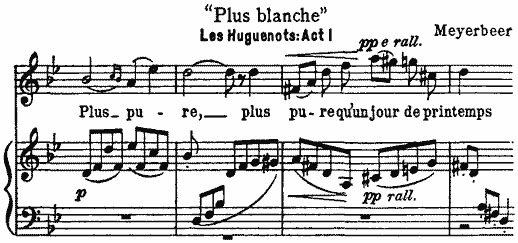
[Listen]
or the concluding phrase of “Celeste Aida” (in Aida, Act I), as
Verdi wrote it and wished it to be sung:

[Listen]
At present the majority of operatic tenors, to whom are assigned the
strong tenor (fort ténor) rôles, can sing the higher tones of their
compass only in forte, and with full voice. Thus an additional and
very charming effect is lost to them. Yet Adolphe Nourrit, who created
the rôle of Raoûl in Les Huguenots, sang, it is said, the phrase as
written. The late Italo Campanini, Sims Reeves, and the famous Spanish
tenor Gayarré, were all able to sing the

[Listen]
mezza voce, by a skilled use of the covered tones.[Pg 10]
I do not ignore the fact that cases occur where artists, owing to some physiological peculiarity or personal idiosyncrasy, are unable to overcome certain special difficulties; where, indeed, the effort would produce but meagre results. But such instances are the exception, not the rule. The lyric artist who is gifted merely with a beautiful voice, over which he has acquired but imperfect control, is at the mercy of every slight indisposition that may temporarily affect the quality and sonority of his instrument. But he who is a “singer” in the real and artistic sense of the word, he who has acquired skill in the use of the voice, is armed at all points against such accidents. By his art, by clever devices of varied tone-colour and degrees of intensity, he can so screen the momentary loss of brilliance, etc., as to conceal that fact from his auditors, who imagine him to be in the possession of his normal physical powers. The technical or mechanical part of any art can be taught and learned, as I have said. It is only a case of well-guided effort. Patience and unceasing perseverance will in this, as in all other matters, achieve the desired result. Nature gives only the ability and aptitude to acquire; it is persistent study which enables their possessor to arrive at perfection. Serious and lasting results are obtained only by constant practice. It is a curious fact that many people more than usually gifted arrive only at mediocrity. Certain things, such as the trill or scales, come naturally easy to them. This being the case, they neglect to perfect their agilità, which remains defective. Others, although but moder[Pg 11]ately endowed, have arrived at eminence by sheer persistence and rightly directed study. It is simply a musical version of the Hare and the Tortoise.
But we must make a great distinction between the preliminary exercises which put the singer in full possession of the purely mechanical branch of his art (Technique), and the æsthetic studies in Taste and the research for what dramatic authors call “the Science of Effect,” or Style. The former must be thoroughly accomplished, otherwise the latter cannot be undertaken satisfactorily. A good and reliable technique is undoubtedly of primary necessity. But it is by no means all. One may have a voice which is well-posed and of good resonance, and also have sufficient flexibility to perform neatly all the rapid passages with which the pages of the classic composers abound. But this is not singing; nor is the possessor of these an artist. He has simply the necessary and preliminary knowledge which should enable him to become one, by further study of the æsthetic side of the art of singing. He has, as it were, collected the materials necessary for the erection of a splendid edifice, and has now to learn the effective means of combining them. So, when the voice is “formed,” a frank and easy emission obtained, a sufficiency of Technique acquired, the next step in the singer’s education is the practical study of the problem of Style.
WHAT is Style?
In reality the question is two-fold. One may have Style; and one may have a style. The former is general; the latter individual. The former can be taught and learned, for it is based on certain well-defined rules; the latter is personal—in other words, is not universally applicable. Not infrequently it is a particular application of those rules which gives the impress of originality. But correct taste must first be formed by the study of the noblest creations in the particular art that claims attention. In singing, as in the sister arts, the laws which govern Style must be apprehended and understood before Individuality can be given full scope. Otherwise, what to the executant would appear as original might, to correct taste and judgment, appear ridiculous and extravagant. A genius is sometimes eccentric, but eccentricity is not genius. Vocal students should hear as many good singers as possible, but actually imitate none. A skilled teacher will always discern and strive to develop the personality of the pupil, will be on the alert to discover latent features of originality and character. He will respect and encourage individuality, rather than insist upon the servile imitation of some model—even though that model be himself. As the distinguished artist Victor Maurel has[Pg 13] justly observed: “Of all the bad forms of teaching singing, that by imitation is the worst” (Un Problème d’Art).
In singing, as in painting, a copy has never the value of the original. Moreover, slavish imitation in any art has a deleterious influence. But to respect irreproachable examples and fitly observe sound rules, whose very survival often justifies their existence and testifies to their value, is always of benefit to the artist. To imitate is to renounce one’s individual expression of an ideal and present that of another. But to observe established and accepted laws, laws founded on Truth and consecrated by Time, is not to imitate, when those laws are applied in an original and individual manner that is in harmony with the personality of the interpreter. “L’art est un coin de Nature vu à travers un tempérament.” In literature, each writer has his own special style which may easily be recognized; but all follow the same grammatical rules. A correct style in singing consists in the careful observance of the principles of Technique; a perfect Diction; the appropriate Colouring of each sentiment expressed; attention to the musical and poetic Accents; judicious and effective Phrasing (whether musical or verbal), so that the meaning of both composer and poet may be placed in the clearest light.
Let us analyze Style in its three principal aspects: Colour, Accent, and Phrasing.[Pg 14]
OF all the elements of Style in singing, the most potent and effective—the one, indeed, that is essential for the success of the lyric artist—is the ability to vary the vocal timbre; that is, to sing with Colour. This desideratum of varied tone-colour is sought even by instrumentalists. Nay, the instrument itself is sometimes constructed with this object in view. Witness the invention of the “soft” pedal, which is intended not solely to reduce the intensity of tone in the pianoforte—that may be accomplished by a modification of force in striking the note—but to give the tones a darker, more sombre quality, or colour. To vary the tone-colour, a violinist or ’cellist draws the bow across the strings close to, or distant from, the bridge, in accordance with his desire for a reed-like or flute-like quality of tone. Anyone who has listened to the performance of the slow movement in Paganini’s Concerto in D, by an Ysaye or a Mischa Elman, will have remarked how the skilful use of varied tone colour and other devices imparts a wonderful charm to music intrinsically of but mediocre value.
A singer may have a good quality of voice; but that is normal. If he can vary it only in degrees of loudness (Intensity) and not in differences of timbre (Colour) he cannot be ranked as an artist. No matter how great the natural beauty and sonority of his voice, his performance will always be monotonous, if he has only one tint on his vocal palette. In speech—from which[Pg 15] the effect is borrowed—utterances of grave and serious meaning, and those of gayer import, are not made with the same colour of voice. A brighter quality (voix claire) is used instinctively for an ejaculation uttered by one to whom pleasant or joyful news has been communicated. On the contrary, should it be the cause of sorrow or grief for the listener, he will use—should he have occasion to reply—a darker quality of voice (voix sombre). Such phenomena are physiological. The vocal organs are the most sensitive of any in the human economy: they betray at once the mental condition of the individual. Joy is a great tonic, and acts on the vocal cords and mucous membrane as does an astringent; a brilliant and clear quality of voice is the result. Grief or Fear, on the other hand, being depressing emotions, lower the vitality, and the debilitating influence communicates to the voice a dull and sombre character.
On this question of colour in the voice, the masterly writer and critic Legouvé says: “Certain particular gifts are necessary if the speech is to possess colour. The first of these is Metal in the voice. He who has it not will never shine as a colourist. The metal may be gold, silver or brass; each has its individual characteristic. A golden voice is the most brilliant; a silvery voice has the most charm; a brassy voice the most power. But one of the three characteristics is essential. A voice without metallic ring is like teeth without enamel; they may be sound and healthy, but they are not brilliant.... In speech there are several colours—a bright, ringing quality; one soft and veiled.[Pg 16] The bright, strident hues of purple and gold in a picture may produce a masterpiece of gorgeous colouring; so, in a different manner, may the harmonious juxtaposition of greys, lilacs and browns on a canvas by Veronese, Rubens, or Delacroix.
“Last of all is the velvety voice. This is worthless if not allied with one of the three others. In order that a velvety voice may possess value it must be reinforced (doublée) with ’metal.’ A velvety voice is merely one of cotton.”[1]
It may be of interest to notice that the quality which in France is designated “timbre,” is called by the Italians “metallo di voce,” or, “metal of the voice.” Those who heard Madame Sarah Bernhardt fifteen or twenty years ago will readily understand why her countless friends and admirers always spoke of her matchless organ as “la voix d’or.”
The late Sims Reeves, the famous tenor, was a perfect master of all varieties and shades of vocal colour, and displayed his mastery with certainty and unfailing effect in the different fields of Oratorio and Opera. In the recitative “Deeper and deeper still,” with its subsequent aria “Waft her, angels, through the skies” [Handel], he ranged through the entire gamut of tone-colour. As Edgardo in Donizetti’s Lucia di Lammermoor, he launched the “Maladetta” phrase of the[Pg 17] curse with a voice that was almost “white” with frenzied rage; while the pathetic sombre quality he employed in the “Fra poco a me ricovero” fitly accorded with the despairing mood and gloomy surroundings of the hapless Edgardo.
Some singers control but two colours or timbres—the very clear (open) and the very sombre (closed), which they exaggerate. In reality, however, the gradations between them can be made infinite by the artist who is in possession of the secret—especially if he has the ability to combine Colour with Intensity.
An illustration of this is found in the example cited in the opening paragraph of the present work:—“For now is Christ risen.” Not only did Mme. Tietjens make a gradual crescendo from the first note to the climax, but the tonal colours were also subtly graduated from a comparatively sombre quality to one of the utmost clearness and brilliance.
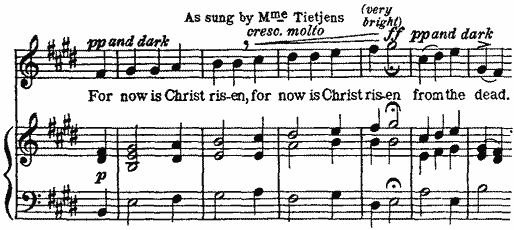
[Listen]
As contrasting examples in which the two principal colours may be
employed effectively, I may cite the[Pg 18] Bacchic air, “Ô vin, dissipe la
tristesse,” and the pensive monologue, “Être, ou ne pas être,” both
from the opera Hamlet, by Ambroise Thomas. The forced, unnatural
quality of the first calls for the use of a clear, open, brilliant
timbre.
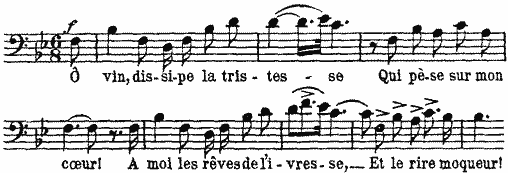
[Listen]
But for the second, “To be, or not to be”:

[Listen]
a sombre, closed timbre is necessary. The opening recitative of
Vanderdecken in Der fliegende Holländer by Wagner would be absurd,
and utterly out of harmony with the character and his surroundings, if
sung in the open timbre. Perhaps I ought to explain that “open” (voix
claire, Fr.), and “closed” (voix sombre, Fr.), are technical terms,
of which the equivalents are accepted in all countries where the art
of singing is cultivated; terms that apply to quality of tone, not
to the physical process by which these effects are produced. Such a
mistake is not infrequently made by vocal physiologists who are not
practical musicians or singing-teachers. Nor must the term “clear
timbre” be understood to[Pg 19] mean the “white voice” (“voix blanche,” or
“voce bianca”); this, like the guttural timbre, being only
occasionally employed for the expression of some violent passion, such
as hate.
Like the admirable paintings of Eugène Carrière, for instance his masterly portrait of Paul Verlaine, a song, sometimes an entire rôle, may be worked out in monochrome; though the gradations of tint are numerous, they are consistently kept within their preconceived colour-scheme. Some few exceptional singers, like Jean-Baptiste Faure or Maurice Renaud, have this gift of many shades of the one colour in their singing of certain rôles. The colour is determined by the psychological character of the personage portrayed; a gay, reckless Don Giovanni calls for a brighter colouring throughout than that necessitated by the music allotted to a gloomy Vanderdecken or an embittered and vengeful Rigoletto. One may, therefore, formulate the following rule: The general character of the composition will decide the tonal colour appropriate for its general interpretation; the colouring necessary for its component phrases will be determined by the particular sentiment embodied in them. Emotions like sorrow, fear, despair, will find fitting expression in the sombre quality of voice, graduated in accordance with the intensity of the emotion. The opposite sentiments of joy, love, courage, hope, are fittingly interpreted by gradations of the clear and brilliant timbre. The dark or sombre voice will be used in varying shades for the recitative from Samson (Handel), “Oh, loss of sight:”[Pg 20]

[Listen]
while the clearest and most brilliant timbre possible to be obtained
is plainly indicated for the same composer’s “Sound an alarm!” from
Judas Maccabæus.

[Listen]
It was a rule formulated by the old Italian school of singing, when
l’arte del bel canto in its true sense did really exist, that no
phrase—musical or verbal—should be repeated with the same nuances.
Very many instances might be given of the happy effect obtained by
observing this rule. One will suffice. It is taken from the Lamento of
Queen Catherine (of Aragon), who, slighted by Henry VIII. for Anne
Boleyn, sighs for her native Spain.

[Listen]
Sudden contrasts of colour are of great dramatic effect. A good
illustration is found in the air “Divinités du Styx,” from Gluck’s
Alceste. This contrast is still further heightened by a sudden
change of both Intensity and Tempo.[Pg 21]

[Listen]
This last phrase, “Ministres de la mort!” should be sung in a very
sombre voice of almost guttural character.
It is, indeed, in the recitatives and declamatory passages of Gluck, Handel, Sacchini, that lyric artists will find unsurpassable material for study. Requiring, as such works do for their perfect interpretation, all the resources of Colour, Accent, and Phrasing, such study is the best possible preparation for the fitting musical presentment of the lyric drama in some of its later phases.
Colour, then, is the basic element of Style in singing. It is reinforced by Accent, which, as the name implies, is the accentuation of details that require to be brought into prominence. This subject, therefore, next claims attention.
IN singing, two kinds of accent are recognized, the Musical accent, and the Poetic, or Verbal, accent. The first appertains to the domain of sound; the second, to the domain of significance. The first, for æsthetic[Pg 22] reasons, throws into relief certain tones of a musical phrase; the second brings into prominence the sentiment underlying the poem or text. Note, also, that in spoken declamation, accent applies to a syllable only; in singing, the verbal accent affects an entire word.
In its relation to Style, the Musical accent must be carefully distinguished from the Metrical accent which is determined by Time, or Measure, as well as from the Verbal accent whereby the import of a word is rendered clear to the listener. Here is an example of Musical accent, from Act III of Verdi’s Ballo in Maschera:
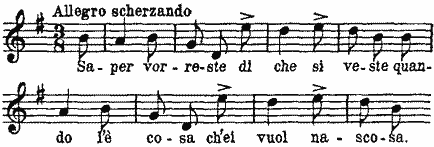
[Listen]
The accents (marked thus
![]() ) give to the musical phrase a
piquancy that is admirably in keeping with the gay and careless
character of the page, Oscar, who sings it. In fact, as regards Style,
Musical accent is particularly valuable in song for the purpose of
setting forth the true character of the music. Hence, it may be
regarded as a means of characterization.
) give to the musical phrase a
piquancy that is admirably in keeping with the gay and careless
character of the page, Oscar, who sings it. In fact, as regards Style,
Musical accent is particularly valuable in song for the purpose of
setting forth the true character of the music. Hence, it may be
regarded as a means of characterization.
This use of accent for characterization is also quite distinct from
its use with “accidentals,” or tones foreign to the prevailing
tonality. In the former case, sentiment dictates its employment; in
the second, the accent guarantees, as it were, the accuracy of the
singer’s[Pg 23] intonation. By the faint stress laid on the foreign tone,
the listener is assured that the executant is not deviating from the
true pitch. In the following examples, the tones marked ![]() are “accidentals,” and for that reason should receive a faint
stress. The first example is from La Forza del Destino.
are “accidentals,” and for that reason should receive a faint
stress. The first example is from La Forza del Destino.

[Listen]

[Listen]
These different uses of accent are well illustrated in the following
example.

[Listen]
The tone allotted to the second syllable of the word “upon” is
accentuated to affirm the accuracy of the singer’s intonation; the
slight emphasis of the word “Him” brings into relief the meaning of
the text. This[Pg 24] latter, then, is an illustration of Verbal, or
“Poetic” accent which, I repeat, throws into relief, without
consideration of its musical value or position, some word of special
significance in the verbal phrase. To render the poetic meaning of the
text clear to the listener, a correct use of verbal accent is
imperative. Its importance and effect, particularly in recitative and
declamatory singing, are analogous to the importance and effect of
emphasis in spoken language. The example is from Samson (Handel):

[Listen]
Here I may point out that in cantabile phrases the stream of sound,
notwithstanding its division into syllables by the organs of
articulation—lips, tongue, etc.—should pour forth smoothly and
uninterruptedly. The full value of each tone must be allotted to the
vowel; the consonants which precede or end the syllables are
pronounced quickly and distinctly. In declamatory singing, on the
contrary, the consonants should be articulated with greater
deliberation and intensity.

[Listen]
Here an emphatic accent on the consonant “n” irresistibly suggests the
idea of knowledge; that is, of absolute certainty, not of mere
belief.[Pg 25]
Very frequently the metrical accent does not coincide with the syllabic accent: the musical accent will fall on an unaccented syllable, or vice versa. Particularly is this the case when the composer is not perfectly familiar with the rules that govern the prosody of the language to which he is setting music. In the operas of Meyerbeer many passages occur in which it is necessary to readjust the syllables to the notes on account of their misplaced accent. Here is an illustration from Hoël’s Grand Air in Le Pardon de Ploërmel (Meyerbeer), Act II. (Note that the tonic accent in French falls always on the last pronounced syllable.)

[Listen]
The error is easily remedied:

[Listen]
In the contralto aria “He shall feed His flock,” in Handel’s
Messiah, the unaccented word “shall” falls on the most strongly
accented note of the bar. If performed thus, it would give a most
aggressive character to the passage, implying that some one had
previously denied the assertion. This would be entirely at variance
with the consolatory and peaceful message that is contained in the
text and shadowed forth in the music.[Pg 26]

[Listen]
Instances of faulty syllabic accent abound in Handel’s works, both his
English oratorios and his Italian operas. Many examples could be
quoted. Here is a phrase from the beautiful air for mezzo-soprano sung
by Ruggiero in the opera of Alcina.
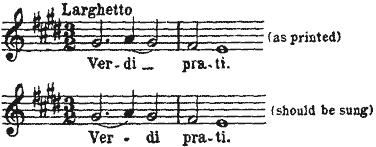
[Listen]
In Mendelssohn’s Elijah, the following phrase is nearly always sung
as written, unless the singer is familiar with the best traditions:

[Listen]
It may be that the artists who slavishly follow the published text
fear being accused of altering the composer’s music, or are ignorant
of the fact that there exists a better version, which is this:[Pg 27]

[Listen]
It will be seen that the music is not changed in the least; the
musical and verbal accents have been merely readjusted and made to
coincide.
In order to avoid the disagreeable effect of singing one half-bar andante to the syllable “si” (pronounced like “zee” in English), the following phrase of Marguerite de Valois in Les Huguenots (Meyerbeer), Act II, is changed thus:
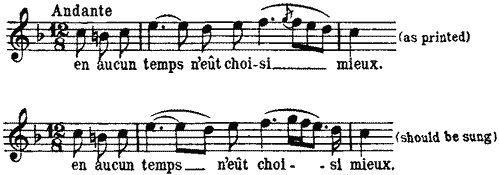
[Listen]
IN musical terminology every gradation of volume in sound, from the
faintest to the loudest, enters into the category of Intensity. One of
the accepted rules of the arte del bel canto was, that every
sustained tone should be coloured by some graduation of intensity.[Pg 28]
Thus the ability to augment and diminish the volume of tone was so
highly esteemed—indeed, so essential—that singers spent much time in
acquiring the messa di voce, that is, the steadily graduated
emission of tone from the softest degree to the loudest and again to
the softest: p ![]() f
f ![]() p. This exercise
invariably formed a part of each day’s study, and was practised on
several vowels throughout the scale, except the extreme tones, save in
rare instances. It was, in fact, indispensable that the singer should
be able to colour every tone in three forms of graduated intensity:
Soft to loud p
p. This exercise
invariably formed a part of each day’s study, and was practised on
several vowels throughout the scale, except the extreme tones, save in
rare instances. It was, in fact, indispensable that the singer should
be able to colour every tone in three forms of graduated intensity:
Soft to loud p ![]() f;
loud to soft f
f;
loud to soft f ![]() p;
and soft to loud and soft again p
p;
and soft to loud and soft again p ![]() f
f ![]() p.
p.
This command of intensity, therefore, is invaluable. But it is even more effective when the artist has the power to combine the various gradations of Intensity with different shades of Colour; in other words, when he can sing a tone crescendo and diminuendo in the clear and sombre timbres.
The passage, already cited, from Alceste’s great air in Gluck’s opera Alceste, furnishes an admirable illustration of the dramatic emotion created by a sudden contrast of Intensity as well as Colour. In the invocation “Ye ministers that dwell in night!” the clear timbre is used with gradually increasing volume until at the phrase (sung adagio) “Ministers of death!” the timbre changes abruptly to a sombre quality with sinister effect, which effect is augmented by being sung pp.[Pg 29]
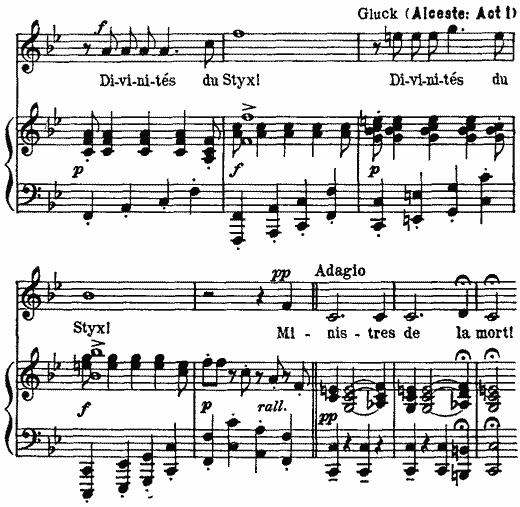
[Listen]
A still more striking example of the impressive effect produced by
sudden contrasts of intensity is offered in the magnificent air “Total
Eclipse,” from Samson (Handel). In it, a judicious use of
tone-colour, accent, and variations of tempo, all combine to elucidate
in the highest possible degree the idea of both composer and poet:[Pg 30]
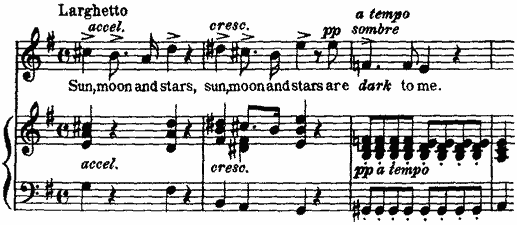
[Listen]
The words “Sun, moon and stars” should be given strongly accentuated,
and the tempo gradually accelerated. The repetition of the phrase
should be sung with still greater intensity; then, at the passage “are
dark to me,” the colour of the voice changes to one of very sombre
quality, and the original tempo is resumed. The first consonant in the
word “dark” should receive a slight stress.
The crescendo has always been a favourite device of composers, particularly of those who write for the lyric theatre. It was an effect held in high esteem by Rossini, who introduced it constantly in his operas—witness his overtures and ensembles. All are familiar with the wonderful crescendo which precedes the appearance of the Knight of the Swan, in Lohengrin, where the sonorities are augmented by gradual additions of voices and instruments until the culminating point is reached. An instance more poignant still is found in the great “Liebestod” in Tristan und Isolde.
Although Hérold, the French composer, observed that in working up to a climax one should begin a long way[Pg 31] off, a singer must be careful not to reach his maximum of vocal sonority before the musical climax is attained. The tenor Duprez created a sensation that is historic, in the long crescendo passage in the fourth act of Guillaume Tell, by gradually increasing the volume of sound, as the phrase developed in power and grandeur, until the end, which he delivered with all the wealth of his exceptionally resonant voice.
Before closing this chapter on Intensity, I should advise singers whose voices possess great natural volume or power not to abuse this valuable quality by employing it too frequently. The ear of a listener tires sooner of extreme sonority than of any other effect. Talma, the great actor, wrought many reforms on the French dramatic stage, not only in costume—prior to his time Greek or Roman dress only was worn in tragedy—but also in the manner of delivering tragic verse. Against the custom, then prevalent, of always hurling forth long tirades at full voice, he inveighed in these terms: “Of all monotonous things, uproar is the most intolerable” (de toutes les monotonies, celle de la force est la plus insupportable). An artistic singer will use his most powerful tones, as a painter employs his most vivid colours, sparingly.
PHRASING is simply musical punctuation. In singing, it may be separated, like accent, into two divisions: Musical and Poetic, or Verbal, phrasing. If the following passage were performed by an instrument, it would not require any particular grouping or phrasing:

[Listen]
But when sung, it would fail in effect if not performed with a very
slight pause after the word “nobis,” thus:

[Listen]
As another illustration of the excellent effect of correct phrasing
may be cited the song Psyché, by Paladilhe. Its effect is heightened
if the musical phrasing be judiciously combined with a change in
Colour and Intensity:

[Listen]
(Should be sung):

[Listen]
It is the clashing of the Musical and Verbal phrasings that often
makes translations of lyric works unsatisfactory. The two phrases are
independent, not welded together. So far from being “Music wedded to
immortal Verse,” these instances resemble those ménages wherein each
unit leads a separate existence. When this is the case, the singer
must decide as to whether the musical phrase, or the poetic phrase,
demands the greater prominence.
The following Phrasing and Colouring would be good and effective if the passage were played on an instrument:

[Listen]
But if sung thus, as it sometimes is by careless artists who pay
little attention to the verbal significance of what they are singing,
it would sound absurd, because the poetic phrasing is entirely
ignored. The correct way of performing the passage (from the aria “Voi
che sapete,” in Act II of Mozart’s Nozze di Figaro) is the
following:

[Listen]
In the next extract (from Act IV in Un Ballo in Maschera, by Verdi),
it will be noticed how oblivious the composer was of the claims of
verbal phrasing. The[Pg 34] whole scena is admirably written for the
voice, and contains many graceful passages of great melodic charm. But
although the music may claim to represent the character of the
situation as a whole, it is disfigured by the complete disregard of
the sense of certain groups of words:
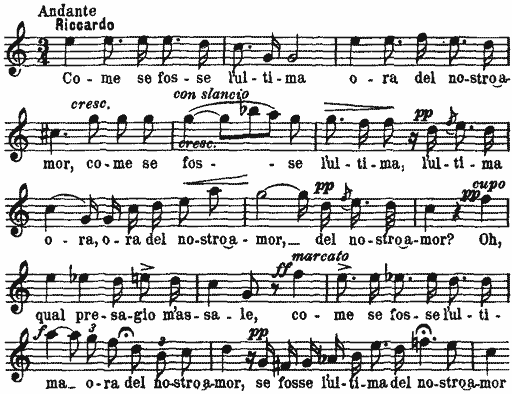
[Listen]
The words “come se fosse l’ultima ora del nostro amor,” constitute
one phrase. It would be extremely difficult, impossible even, for
many, to sing the passage in one breath. But the first musical phrase
ends after the word “ultima;” to separate it from the next word,
“ora” (second and third bars), thus: “last—hour,” is impracticable.
It would be out of the question to destroy the musical phrase by
breathing after the word[Pg 35] “ora,” in the third bar. If the text is
phrased when spoken as it is when sung, the incongruity is at once
apparent. The published score gives a pause
![]() after the
word “ora:” “ultima ora
after the
word “ora:” “ultima ora
![]() del nostro amor.” This
phrasing is good and effective, especially if the artist changes at
once to the sombre quality after the pause, and finishes the phrase
piano and rallentando. One very often hears it, however, given
with a pause for breathing after the high a; the unfortunate singer
having prolonged the tone until, in order to continue, he is compelled
to take in more air. The result is the absurd phrasing given below:
del nostro amor.” This
phrasing is good and effective, especially if the artist changes at
once to the sombre quality after the pause, and finishes the phrase
piano and rallentando. One very often hears it, however, given
with a pause for breathing after the high a; the unfortunate singer
having prolonged the tone until, in order to continue, he is compelled
to take in more air. The result is the absurd phrasing given below:

[Listen]
In the final cadenza, the composer has cut out the word “ora”
altogether. The whole air is of interest to the musical student, as it
shows clearly the little value attached by Verdi, at that period of
his career, to the exigencies of the verbal or poetic phrase. This
neglect of the verbal punctuation is in marked contrast to the care he
bestowed on it in his later works, witness Aida, Otello, and
particularly Falstaff.
Here I may say that it is sometimes necessary to alter the words on account of the impossibility of performing certain passages as written. In the earlier published scores of Samson et Dalila (Saint-Saëns), the following passage in Act II, “Mon cœur s’ouvre à ta voix,” as the composer wrote it, occurs as one phrase:[Pg 36]

[Listen]
This being impracticable of execution in one phrase, and there being
no opportunity of retaking breath until the close of the passage, it
was altered in the later editions, and now stands thus:

[Listen]
This device of repetition, applied either to a word or to part of a
phrase, is perfectly justifiable in cases where the artist, for
physical reasons, is unable to sing the phrase in one breath. I give
an excerpt from Weber’s Der Freischütz (Grand Air, Act II):

[Listen]
This may be sung:

[Listen]
The concluding bars of the waltz-song in Act I of Gounod’s Roméo et
Juliette, are often phrased as indicated in the brackets, in order to
give the singer a chance to take breath, which is done after the c
natural:[Pg 37]

[Listen]
As discrepancies between the musical and verbal phrases, such as those
I have instanced, abound in certain of the old operas which still keep
the stage and form a part of the permanent répertoire of every lyric
theatre, the artists singing them are compelled to choose between
sacrificing the words or the music. The former alternative is
generally preferable, the musical phrase in many such cases being of
the greater relative importance. Another way is, to meet the
difficulty boldly by supplying another text which mates itself more
happily with the musical phrase. Personally, I adopt the latter
alternative without hesitation, when preparing artists to sing these
works.
Some minor effects utilized in Style in singing may be briefly alluded to: Portamento; variations of Tempo.
THIS is effected by the voice gliding from one tone to another, and is equally available on stringed instruments, the violin or ’cello, the mandoline or zither. It is a grace of style much abused by inartistic singers.[Pg 38] Being an ornament, good taste dictates that it be used sparingly. A frequent sliding from one tone to another is a grave fault, and most disagreeable to a cultivated ear. To sing legato is one thing; to sing strisciato is another. Hence, its use on two consecutive occasions is rarely admissible. But without a sober and discreet use of the portamento, the style of the singer appears stiff, angular—lacking, as it were, in graceful curves.
It must always be performed by carrying the tone and syllable to the next tone; never by anticipating the latter:

[Listen]
But it sometimes happens that, while desiring this grace, the composer
does not indicate his wish quite correctly. Here is an instance by F.
Thomé:

[Listen]
Were it performed as printed, it would be very bad style, as it
violates the rule that the succeeding syllable shall not be
anticipated. Undoubtedly, what the author wished is the following:

[Listen]
Sometimes the composer himself indicates clearly his intention that
this effect should be used, as in the following examples:

[Listen]

[Listen]
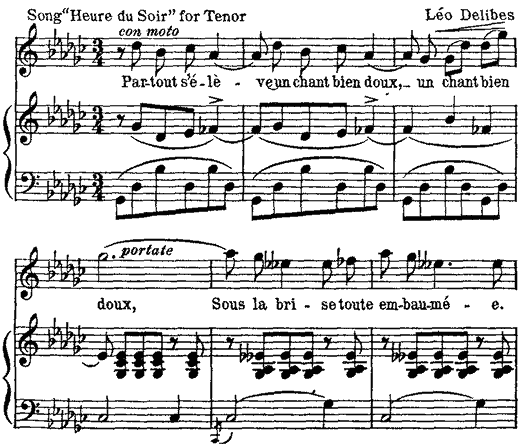
[Listen]

[Listen]
(Notice the phrases marked a and b.)
The words and indications for the use of the portamento in each of these last four examples are by the respective composers, and as printed in the published editions.
A portamento should never be sung so slowly as to convey the idea of a badly executed chromatic scale; and, as a rule, it is best not to use one between any lesser interval than a third, unless for some particular effect, or at the close of a slow movement, as in the aria “He was despisèd,” in The Messiah:

[Listen]
It is also effective in connecting syllables in phrases of a smooth,
lyric character:
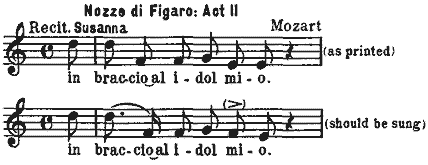
[Listen]
The portamento being an embellishment that pertains to the
cantabile, it is very little used in declamatory singing.
But frequently in the Recitatives of classic works occur phrases of declamatory recitative, interspersed with passages that are purely lyric in structure. To each of these divisions must be given its appropriate style. For instance, after the opening phrases of Obadiah’s exhortation, “Ye people, rend your hearts,” in Elijah, up to the end of the phrase “Return to God,” all is purely lyric declamation. But at the words, “For He is slow to anger, and merciful,” this should cease, and the succeeding phrases be given with all the graces that are permissible in cantabile singing; not in the hard, dry manner affected by some of the modern tenors in oratorio.

[Listen]
THESE are of value in bringing out the musical and poetic significance of certain compositions; notably the operas of Bellini, Donizetti, and the earlier works of Verdi. But I would caution singers to exercise dis[Pg 42]cretion in this much-abused effect. Variations of Tempo, the ritardando, accelerando, and tempo rubato, are all legitimate aids demanded by Expression. But unless their use is determined by sound judgment and correct musicianly taste, the effect speedily becomes vulgar and monotonous. Knowledge, and a taste formed in good schools, must be the guide of the vocalist in the use of variations of tempo.
I have said that the operas of Bellini, Donizetti and Verdi abound in instances requiring the hastening or slackening of the tempo. But the device is also highly esteemed by the ultra-modern Italian school, as may be seen in studying the scores of Puccini, Mascagni and Leoncavallo.
Here is an illustration of its effective use in the air “Connais-tu le pays?” from Mignon (Act II), by Ambroise Thomas. Madame Christine Nilsson (Countess Casa Miranda), who “passed” the rôle with the composer, always sang the phrase thus, although these indications do not appear in the published version:

[Listen]
Again, in the fine song Der Asra, by Rubinstein, the musical, as
well as the dramatic, effect of the poem is heightened by the use of
the accelerando, which interprets[Pg 43] with musical vividness the
impetuous avowal by the slave of his passion for the princess, after
his calm answer to her questions as to his name and birthplace.
“Ich heisse Mahomet, ich bin aus Yemen, und mein Stamm sind jene Asra, welche sterben, wenn sie lieben.” (Heine.)

[Listen]
TRADITION plays a more important part, perhaps, in the interpretation of the classic composers’ writings for the voice than it does in their purely instrumental works. The old masters left few—sometimes not any—indications as to the manner in which their music should be rendered. Thus its proper performance is largely determined by received oral tradition. The printed scores of the classics, except those that have been specially edited, throw little light on their proper interpretation, or even at times on the actual notes to be sung. To perform exactly as written the operas of Gluck, notably Armide and Orphée, the operas of Mozart, the Italian operas and English oratorios of Handel, the oratorios of Bach, Haydn, and Mendelssohn, would be to do the greatest injustice to these composers and their works.
It is a prevalent idea that all departures from the published text are due either to caprice, or to vanity and a desire for personal display on the part of the soloist. As though singers had a monopoly of these defects!
Let us consider some of the principal causes of such changes in the text, and the reasons why these modifications do not always appear in the published versions.
In the original editions of many of the earlier operas, as those of Mozart, etc., the unaccompanied recitative[Pg 45] (recitativo secco) is not barred. As with the plain-chant of the church, only the pitch of the tone is indicated. Its length was left to the discretion of the artist, who was supposed to be familiar with the accepted style of delivery termed “recitativo parlante.” The example is from the recitative “Dove sono,” in Act III of Le Nozze di Figaro, by Mozart:

[Listen]
This should be sung as below:

[Listen]
The substitution of another note for the one actually written, both in
Recitative and Aria, was also strictly regulated under the system or
convention then in vogue, one perfectly understood both by composer
and singer.
In all the earlier Italian operas, and in the English oratorios of Handel, this system was followed:
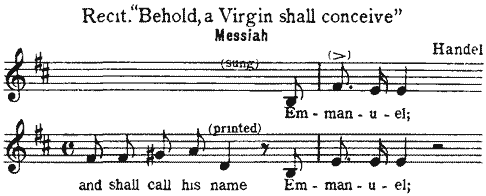
[Listen]
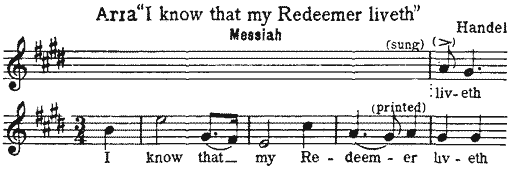
[Listen]
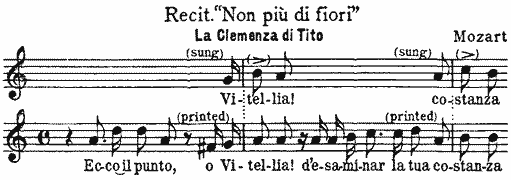
[Listen]
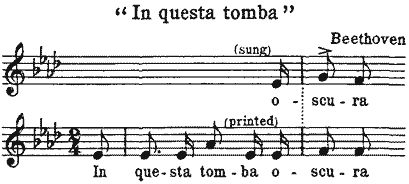
[Listen]
This substitution, therefore, of another note—a tone or semitone
higher or lower, according to the phrase—is not only legitimate but
essential in all music written in the Italian manner.
Another cause of changes being necessary in the vocal part of many of the older classic writers, particularly of oratorio, is the frequently faulty syllabic accentuation. I have already mentioned this defect in the chapter on Accent. Handel, for instance, although living nearly all his life in England, never became quite[Pg 47] master of its language; hence the numerous cases of the misplacing of syllables in his oratorios. This defect is also noticeable, but not in the same degree, in his Italian operas. The books of Elijah and St. Paul (Mendelssohn), and The Creation (Haydn), were originally written in German, and therefore suffer somewhat in this respect when the translated English version is given. This fault is also noticeable in the English versions of Bach’s Passion (St. Matthew), and Mendelssohn’s Psalm CXIV. In the first quoted of these two works, in the response for Double Chorus to the question, “Whether of the twain will ye that I release unto you?” the accent falls on the first syllable “Ba-rab-bas”; in the second of the two works (114th Psalm), the accent is placed on the last syllable, thus: “Hal-le-lu-jah.” Neither of these accentuations is in accordance with English custom.
A singer, therefore, is perfectly justified in rearranging the syllables in order that, as far as possible, the musical and verbal accents shall coincide. But there are rigorists, unaware of the usages and conventions previously spoken of, who are very severe in their judgment when any deviation is made from the printed score with which they follow the performance of classic works. Such severity is unmerited, because unjust. Although such persons sometimes inveigh against any and every change from the strict letter of the printed music—ignorant of the possibility, that only in this way can its spirit be respected—the changes in a multitude of cases are essential because due (1) to reverential deci[Pg 48]phering of an obsolete musical notation, (2) to improvements in musical instruments, or (3) to the sanction and authority of the composer himself.
Sometimes it is an orchestral conductor who reproaches the solo singers with their want of respect for the composer, because he hears at times interpolations or changes which find no place in his own score. The singers are accused of “altering the composer,” of “taking liberties with the text.” And yet these very changes may be traditionally correct; they may be in accordance with rules and conditions prevalent at the time the music was written, and employed on account of a desire to interpret the composer’s own intentions, and not from mere vanity or caprice.
Nor are these necessary changes and departures from the printed scores of the classics confined to the vocal parts of the music composed by the old masters. As a matter of fact, the deviations which, in performance, are sometimes made from the printed edition of a musical composition, arise from a variety of causes.
One of these is the discrepancy that exists between various editions of the same work; and sometimes the confusion is complicated by different versions having been prepared by the composer himself. This is notably the case with Gluck’s Orphée, first written to an Italian libretto by Calzabigi and produced at Vienna. When Marie Antoinette called her former Viennese singing-master, Gluck, to Paris, she gave him an opportunity of displaying his genius by facilitating the production of his Iphigénie en Aulide at the Opéra, in 1774. Its[Pg 49] enthusiastic reception recalled to the composer the like success which had attended the production of his Orfeo at Vienna. He immediately set to work to revise it for the Paris Opéra, and fit it to a new French text, the latter supplied him by Moline.[2]
But the title-rôle in the original Italian version was written for, and sung by, Guadagni, an artificial contralto (contralto musico). In its newer French dress the part was transposed and rearranged for the tenor Legros; who, judging from the extreme altitude of the tessitura employed, must have possessed either a haute-contre, or a very high light-tenor voice, and who may have employed the falsetto. This high tessitura, combined with the fact that the pitch has risen considerably since it was composed, renders the French version impracticable for tenors of the present day. Here are the concluding bars of the famous air as written in the original Italian version, and the same phrase as altered by Gluck, when produced in Paris.
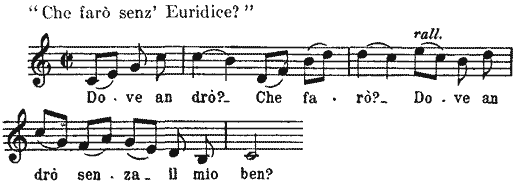
(As originally written by Gluck for the Italian version, Vienna.)
[Listen]
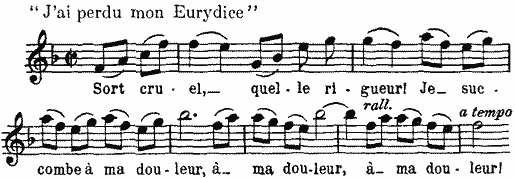
(As altered by Gluck for Paris; sung by the tenor Legros. From a manuscript copy, Bibliothèque de l’Opéra.)
[Listen]

(As sung by Mme. Viardot-Garcia, Théâtre-Lyrique, Paris; the part being restored to the original voice and key, but the change at the end, made for Legros, retained.)
[Listen]
The finale to the first act was also changed; a tumultuous “hurry” for
strings, evidently designed to accompany the change of scene to Hades,
being now replaced by a florid air, probably introduced at the desire
of the principal singer as a medium for the display of his vocal
virtuosity; a concession often exacted from composers of opera. This
interpolated air was for a long time attributed to a
composer—Bertoni—who had himself composed an opera on the subject of
Orphée. Later researches have, however, proved that this air[Pg 51] is by
Gluck himself, taken from Aristeo, one of his earlier works. When
the famous revival of Orphée took place at the old Théâtre-Lyrique
in Paris, the rôle of Orphée was restored to the type of
voice—contralto—for which it was originally composed, and confided
to Mme. Pauline Viardot-Garcia. She retained the air introduced for
the tenor Legros, but of course transposed, and with a reorchestration
by Camille Saint-Saëns; the now famous composer having at that time,
by the request of Berlioz, undertaken to continue and complete the
revision of Gluck’s complete works, known as the Pelletan Edition.[3]
Other changes from the first Italian score were also made by Gluck in the later French version. Here is an example; being the recitative immediately preceding the great air of Orpheus in the last act:
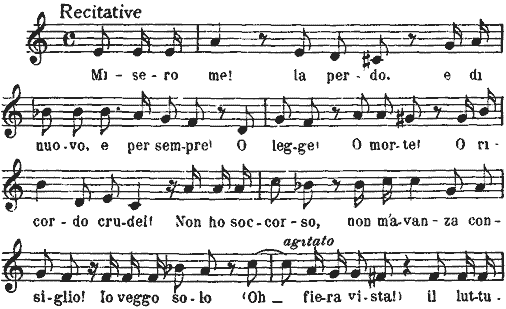

(Original Italian version, as written for Vienna.)
[Listen]
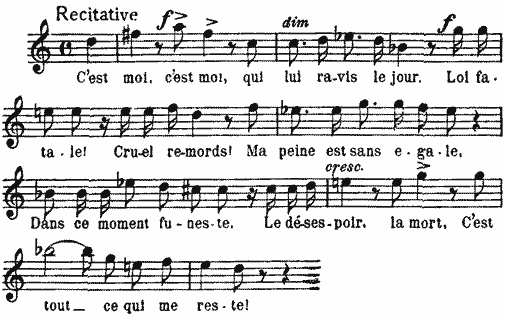
(As written for the Paris version, the rôle of Orphée being then sung by a tenor.)
[Listen]
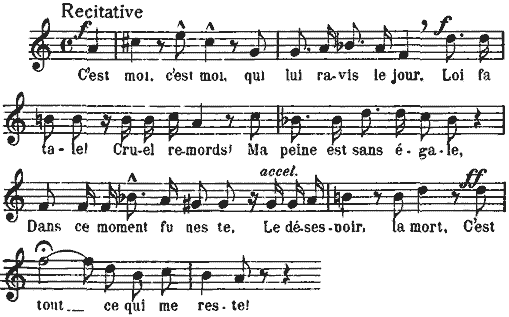
(As sung by Mme. Viardot-Garcia, the rôle being then restored to the contralto voice as in the Italian version, while the changes made by Gluck for the Paris version were retained. This is now definitively adopted at the Opéra-Comique.)
[Listen]
Again, discrepancies exist between various published copies of the
same work, arising from the fact that sometimes the editors of these
revisions may have mistaken the intentions of the composer. Or,
influenced by pardonable human vanity, they may have felt impelled to
collaborate more directly with the composer, by adding something of
their own.
There is valid reason for the additional accompaniments, with which Mozart has enriched the original scores of Handel’s Messiah and Alexander’s Feast; and we have evidence of the skill, and can divine the reverence, with which these additions were accomplished. But how fatal would have been the results, had the delicate task been attempted by one in whom these qualities were lacking! Also, there is every excuse for the additions made to Gluck’s Armide by Meyerbeer for the Opera of Berlin; and we have the direct testimony of Saint-Saëns, who has examined this rescoring, as to the rare ability and artistic discretion with which the work has been done.[4]
From this evidence it appears that in the score as left by Gluck, the trombones do not appear at all in Armide. The drums, and stranger still, the flutes, are heard only at rare intervals; while the whole orchestration—sometimes a pale sketch of the composer’s intentions—shows a haste and lack of care in marked contrast with the pains bestowed on the scoring of Alceste, Iphigénie, and Orphée. The revisions and additions spoken of were undertaken by highly competent author[Pg 54]ities, actuated only by the wish to restore in its purity the idea of the composer; and who to zeal, added the more valuable quality of discretion.
Ancient music, owing to the development of and changes in the instruments for which it was composed, can rarely be given as written by the author. Even if the instruments of modern invention be eliminated, the orchestra of to-day is not the orchestra of Handel. The oboe, for example, has so gained in penetrating power that one instrument to each part now suffices; in Handel’s time the feeble tone of the oboe rendered a considerable number necessary. The perfection of certain instruments, too, is the cause of modifications in the music written for them. The limited compass of the pianoforte, for example, was certainly the sole reason why Beethoven failed to continue in octaves the entire ascending scale in one of his sonatas. Had the piano in his day possessed its present compass, he would undoubtedly have written the passage throughout in octaves, i.e., as modern pianists play it. If a rigid adherence to the printed letter of ancient music is to be strictly observed, without consideration of the many causes that render this procedure undesirable, let consistency be observed by pushing the argument to its logical conclusion, viz., returning to the instruments used, and the composition of the orchestra that obtained, when these works were written. Those who accuse artists of introducing changes, of not performing the music as the composer wrote it, should be quite sure as to what the composer really did write, since many[Pg 55] changes are made both before and after the work is printed. They should also be certain that these changes are not such as the composer may have, or would have, sanctioned, seeing that by their use his meaning is more clearly expressed.
At the Concerts Spirituels, given at the Church of the Sorbonne, Paris, may be heard very excellent performances of Oratorio by ancient and modern composers, from Handel and Bach to Claude Debussy; though I do not know whether or no l’Enfant prodigue (The Prodigal Son), by Debussy, is properly styled an oratorio, seeing that it was recently given in London on the stage as an opera. These performances at the Sorbonne are marked by a reverential attention to detail; the soloists, chorus and orchestra being very competent, and the conductor—M. Paul de Saunières—a musician of ability and experience. In spite of these great advantages, however, the works of several of the old classic composers suffer somewhat, by certain authentic traditions and conventions being either unknown or ignored. To cite only one instance out of many: At the Sorbonne, the opening bars of the second movement of the Recit. in The Messiah, “Comfort ye my people,” etc., are performed as printed:
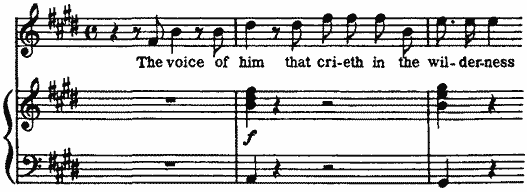
[Listen]
This music is written in the Italian “manner,” consequently its
performance should be in conformity with the usages and conventions
which obtained when the work was composed. One of these, as I have
pointed out, was the substitution of one note for another in certain
places; another, that in declamatory recitative, or recitativo
parlante, the chord in the orchestra should come after the voice
(“dopo la parola”). These words appear in many scores of the Italian
operas, even of the present day. But when they do not, the musical
director is supposed to be familiar with the custom. The following,
therefore, is the authentic mode of performing the passage in
question:
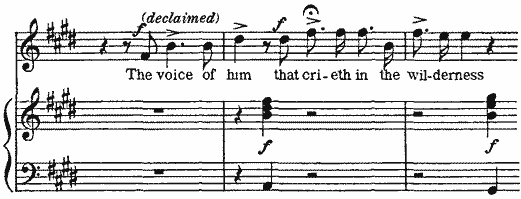
[Listen]
Apart from these defects in the rendering of the ancient classics, it
would be unjust not to acknowledge the great artistic merit and value
of the performances, given—as Oratorio should be—in the church. To
hear l’Enfance du Christ (Berlioz) as performed at the Sorbonne,
with its particular facilities for obtaining the ppp effects of the
distant or receding angelic chorus, is[Pg 57] to be impressed to a degree
impossible of attainment in the concert-room.
Let those purists who resent any “tampering”—as they term it—with the composers’ music listen to the following phrase, sung as it is printed in the ordinary editions:

[Listen]
Then let them hear it given according to the authentic and accepted
tradition, and say which of the two versions most faithfully
interprets the composer’s meaning.

[Listen]
Let us now consider alterations which do not appear in the printed editions, and yet may have been made or sanctioned by the composer.
In comparison with painting and sculpture, music and the literature of the theatre are not self-sufficing arts. They require an interpreter. Before a dramatic work can exist completely, scenery, and actors to give it voice and gesture, are necessary; before music can be anything more than hieroglyphics, the signs must be transmuted[Pg 58] into sound by singers or instrumentalists. Wagner embodied this truth in his pathetic reference to Lohengrin: “When ill, miserable and despairing, I sat brooding over my fate, my eye fell on the score of my Lohengrin, which I had totally forgotten. Suddenly I felt something like compassion lest the music might never sound from off the death-pale paper.” In other words, Lohengrin, though finished in every detail, was merely potential music. To make it anything more, the aid of singers and orchestra are essential.
Composers and dramatic authors, in fact, create their art-works; but it is their interpreters—actors, singers, instrumentalists—who animate them, who breathe life into them. One of the inevitable consequences is, that the composer’s ideal can never be fully attained.
But changes in performance from the printed text of a composition are frequently the work of the composer himself. If really an artist, he is rarely perfectly satisfied with his completed work. The difference between his ideal and his materialization of it, is a source of anguish for him. The journey made by a vision of art from the brain that conceives it to the hand that imprisons it in marble, or depicts it in colour, or pens it in words or music, is a long one. And much grace or power, beauty or grandeur, is inevitably lost on the way. This is the explanation of the disappointment of all true artists with their creations. This is the origin of their endless strivings to perfect their works; the first embodiment is not a perfect interpretation of the artist’s inspiration, and further reflection[Pg 59] has revealed to him an improvement. The process is endless.
A man’s reach should exceed his grasp,
Or what is Heaven for?
If one wishes to surprise genius labouring to give birth to perfection, one should consult the later editions of Victor Hugo’s works and note the countless emendations he made after their first publication—here a more fitting word substituted, there a line recast, elsewhere an entire verse added, or excised, or remodelled.
This work of incessant revision is not restricted to poets. Composers of genius are also inveterate strivers after perfection, are continually occupied in polishing and revising their music. And not all the modifications they make, or sanction, are recorded in the printed versions. For many are the outcome of after-thoughts, of ideas suggested during the process of what I have called transmuting musical hieroglyphics into sound. Such modifications, usually decided upon in the course of a rehearsal—I am now considering particularly operatic works—are frequently jotted down, a mere scanty memorandum, on the singer’s part or the conductor’s score. But they are the work of the composer, or have received his approval, and, although not noted in the printed editions of his compositions, are transmitted orally from conductor to conductor, singer to singer, master to pupil. And thus a tradition is perpetuated.
But the question of changes goes even further.
Prior to the advent of Wagner, the singer was allowed[Pg 60] great license in operatic works. This license was principally manifested in a two-fold form. The first is called pointage (French), puntatura (Italian), and means the changing of the notes or contour of a musical phrase; the second is termed changements or variantes (Fr.), abbellimenti or fioriture (It.), and refers to the interpolation and addition of ornaments, i.e., embellishments and cadenzas.
THIS, as I have said, is the technical term given to the modification or rearrangement of the notes of a phrase, so as to bring it within the natural capabilities of the artist singing the rôle. A few illustrations will make the nature of pointage clear.
In Rossini’s Guillaume Tell, although it is written in a different style from his former works, whence less necessity for interpolations and modifications, occurs the following terrible passage for the principal baritone:

[Listen]
Every vocalist knows the difficulty experienced in singing very high
tones to different syllables, each requiring a different conformation
of the buccal cavity. The passage quoted—expressing Tell’s bitterness
at the recollection of his past sufferings in prison, “Well I know the
weight of galling chain”—has to be declaimed with great energy. So
far as the relative value of the notes is concerned, it is entirely
ad libitum, the rhythmical figure in the orchestra having ceased one
half-bar before. It is said that Dabadie, a basso cantante rather
than baritone, to whom was entrusted the rôle of Tell on the first
production of the work at the Opéra, Paris, on August 3, 1829, finding
it impossible to sing the phrase as written, had recourse to a
professor. He advised the pointage given later. This change became
traditional,[Pg 62] and has since been followed, except, it is said, in the
case of Massol, who succeeded Dabadie. He, being possessed of a very
sonorous voice of exceptional compass, was able to give the phrase as
written. This change, or pointage, must have been heard by Rossini,
and so must have been tacitly approved by him. This is the change made
by Dabadie:

[Listen]
In Italian lyric theatres, pointage becomes necessary in many French
operas, owing to the prevalent custom of allotting to contraltos
certain rôles written for soprano and known as “dugazon rôles” (from
Madame Dugazon, who created the type). The parts of Siebel in Faust
(Gounod), Urbain in Les Huguenots, Stéphane in Roméo et Juliette
(Gounod), are all written for soprano, and when sung in Italian
require not only transposition of the principal airs, but the use of
pointage in passages where transposition is impossible owing, for
instance, to the participation of other characters in the scene. Thus
the air sung by the page Urbain (Les Huguenots) on his entrance is
sung in the French theatres as written by Meyerbeer, i.e., in B
flat. In theatres where the Italian version is given, this air is
transposed a third lower into G, necessitating later numerous
pointages, for the reason already given.
I said that many deviations from the printed text are the work of the author, or are authorized by him. A[Pg 63] moment’s reflection will convince one of the truth of this statement. The singer chosen—usually by the composer himself—to “create” a rôle, i.e., to interpret for the first time some part in a new opera, generally studies it with the composer, or under his direct supervision, and thus learns, directly or indirectly, his ideas as to the meaning, style of execution, tempi, etc., of the music. Very often during rehearsals, when the composer begins really to hear his own work, he makes modifications in certain passages, alterations of the words or suppressions of the notes that are either ineffective, or lie awkwardly for the voice. But the opera has already been printed for the convenience of the singers and choristers studying the rôles and choruses; consequently, such modifications, rearrangements, and “cuts” (as excisions are termed), do not find their way into the published scores.
Meyerbeer, as I have been informed by competent authorities, was constantly modifying his compositions. With him, the work of revision and emendation was never finished. It is said that this was more especially the case with his last opera, l’Africaine, which he was continually altering and revising, never being able to satisfy himself. Two versions of the libretto were prepared for him by Scribe, and two distinct settings of the music are published, although only one is performed.[5]
In Nelusko’s first air occurs the following passage, in which a great crescendo is marked, culminating ff on the word rien:

[Listen]
Although the opera was produced after the composer’s death,
Jean-Baptiste Faure, the great baritone chosen to create the rôle of
Nelusko, studied it with Meyerbeer, who authorized several verbal and
musical changes in it.

[Listen]
Without the first alteration it is impossible to realize the
composer’s wish for a climax on the word “rien”; the second change
is due to the fact that the tessitura of the phrase is somewhat
high, and Faure, who was a low rather than high baritone, dreaded the
high f♯.
Indeed, it was for this latter reason that this most accomplished singer never sang in Verdi’s operas. According to his own statement, he had to deny himself this pleasure, because most of the baritone parts in the Italian composer’s operas are written in a high tessitura.
When Gounod wrote his Faust for the Théâtre-Lyrique, Paris, spoken dialogue was used in place of the recitatives subsequently added by the composer when the work passed, ten years later, into the répertoire of the Opéra. In its earlier form, therefore, it belonged to the category[Pg 65] of opéra-comique, in which tenors were then permitted to use the falsetto voice for their very highest tones. This custom, though sanctioned in opéra-comique, was not permitted or accepted in grand opéra, to which Gounod’s work in the revised form now belongs. At the beginning of the sixth bar from the end of the tenor cavatina in the Garden Scene: “Salut! demeure chaste et pure,” occurs the high sustained c.
Not all tenors who sing the rôle are possessed of the much-coveted “do di petto,” so a discreet pointage becomes a necessity, since the tone was originally intended, as I have said, to be sung in falsetto. Those robust tenors who, possessing this tone, launch it out at full voice, unheeding the delicate accompaniment with violin obbligato in the orchestra, and the calm, mystic serenity of the surroundings, are surely more desirous of drawing the attention of the public to themselves, than actuated by an artistic desire to interpret faithfully the scene as intended by composer and librettist.
It was owing to the use by light tenors of the so-called falsetto voice, now no longer in favor with the public, that such of the opéras-comiques by Boiëldieu, Halévy, Auber, etc., which still keep the stage, necessitate frequent pointage, in order to render their execution compatible with existing requirements. Sometimes a composer utilizes an exceptional voice, as was the case with the rôles written for Martin. This singer must have possessed either a strong tenor voice with exceptional low tones, or a baritone voice with perhaps an unusual command of the falsetto—history furnishes but vague[Pg 66] information on this point. In any case, the rôles written for him—called Martin-tenor or Martin-baritone parts—are now assigned to the ordinary baritone. Pointage then becomes inevitable, as in the case of Hérold’s Zampa, the compass required as printed being from

[Listen]
In the rôles, such as Mignon (Thomas) and Carmen (Bizet), written
for Madame Galli-Marié, their respective composers themselves have so
arranged the parts that they may be sung by either mezzo-soprano or
soprano. The rôle of Mignon has alternatives, in order that it may be
sung by three types of female voices. The roulades and cadenzas were
subsequently added by the composer for Madame Christine Nilsson.
If the rôle is sung by a high soprano, Mignon’s first air, “Connais-tu le pays,” is transposed a tone higher into E flat.
In the famous duet between Raoûl and Valentine in the fourth act of Les Huguenots, the composer has given alternative notes for those tenors who do not possess the exceptional altitude required for the higher of the two:
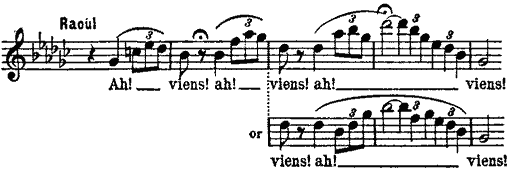
[Listen]
I heard recently, however, a performance of this opera, in which the
tenor sang the whole of the music as written, without either
transposition or pointage. So it was sung, I should imagine, by the
famous Adolphe Nourrit, who created the rôle; but the pitch at that
time (1836) was lower than it is at present.
Thus composers have recognized the necessity at times of pointage in certain rôles written for exceptionally gifted singers, in order to render possible to the many that which was originally written for the few.
Changes from the published version have also been made—and proving effective have passed into tradition—by singers who, exercising the liberty then accorded them by composers, have slightly modified certain passages for several reasons: for instance, to augment the effect by making the phrase more characteristic of the vocal instrument, or to express more forcibly the composer’s idea.
The following illustrations will render my meaning clearer. The changes originated in the causes I have mentioned, and are attributed to Madame Dorus-Gras:
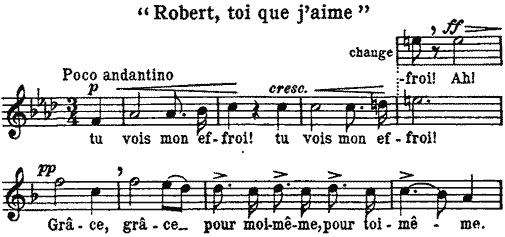
[Listen]
The phrase “Grâce, grâce,” in which Isabelle implores Robert of
Normandy’s forgiveness, occurs three times. When it recurs for the
last time, a change from the printed text is not only justifiable; it
is demanded, in order to give additional intensity and power to the
phrase, and to avoid the monotony caused by mere repetition. This
modification is all the more defensible, as the composer has
substituted the orchestra, with the strings tremolo, for the
rhythmical harp-figure with which he accompanies the phrase on its
first and second presentations. Here is the accepted traditional
change:

[Listen]
Again, to sing the final cadenza of this air as Meyerbeer briefly
indicated it, would be impossible and absurd:
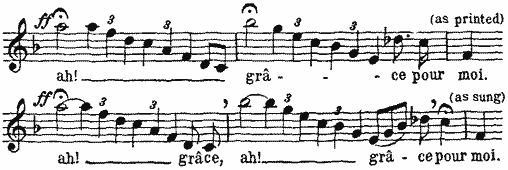
[Listen]
Other changes have their origin in the fact that sometimes a great
climax is rendered impossible of realization because the musical
phrase culminates on a vowel-sound difficult of emission on that note,
and devoid of sonority; another word has sometimes to be substituted.[Pg 69]
For this reason, in the first air of Alice in the same opera
(Robert), “Va, dit-elle,” a verbal rearrangement is always
resorted to:

[Listen]
To avoid the disagreeable and ineffective result produced by the high
descending passage on the word “lui” (pronounced in English as
“lwee”), the last few bars are performed thus:

[Listen]
When La Tosca (Puccini) was produced in French at the Opéra-Comique,
Paris, the unfortunate artist to whom was allotted the tenor rôle was
expected by the translator to sing at full voice, and after a crashing
chord from the entire orchestra, marked ffff in the score, the
following words:

[Listen]
As it was found to be out of the question to produce[Pg 70] the effect
desired with the words as they stood, the phrase was afterwards
changed to:

[Listen]
Frequently modifications, most happy in their effect, are due to the
inspiration of a particularly gifted artist.
Madame Viardot-Garcia, finding the phrase of the cabaletta in the aria “Se Romeo t’uccise” (Romeo e Giulietta, Bellini) somewhat weak and ineffective, made the skilful pointage here given:
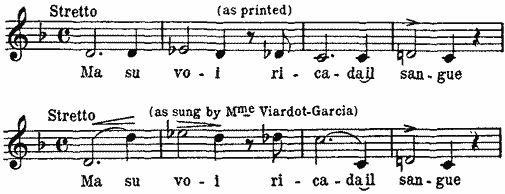
[Listen]
A great artist may feel at times the inadequacy of the phrase as it
stands to convey justly the composer’s idea. Take, for instance, the
well-known change which every soprano who sings the rôle of Leonora
introduces in the Miserere scene of Il Trovatore. The passage
occurs four times in succession, and as printed becomes commonplace
and monotonous.

[Listen]
The accepted traditional change certainly conveys the impression of
Leonora’s gradually increasing anguish and terror; not the idea that
it is introduced merely to exploit a high tone:

[Listen]
That this departure from the text must have been sanctioned by Verdi,
is, I think, proved by the fact that it has always been sung thus, and
the composer himself must often have heard the substitution. He would
certainly have forbidden its use, had he not approved of it, for he
was particularly averse to having changes made in his music. The
following anecdote illustrates this trait in his character. It was
related by the late Mme. Marie Saxe, better known under her
Italianized name of Marie Sasse. This distinguished soprano singer, a
member of the Paris Opéra for a number of years, was engaged to give a
certain number of performances at the Opera of Cairo. Aida was one
of the operas stipulated for in her contract. She had never sung the
rôle, and in studying it found the tessitura of the music, at one or
two points, a little too high for her natural means. As she was
compelled by her contract to sing the opera, she asked Verdi to make
some slight changes to bring the music within her reach. But he
refused absolutely to make the least alteration.
Madame Saxe was specially selected by Meyerbeer to create the rôle of Sélika in l’Africaine. She studied the[Pg 72] part for three months with the composer, and sang it when the work was first given at the Paris Opéra. She was also chosen by Richard Wagner for the part of Elisabeth when Tannhäuser was given its stormy performances, with Niemann in the title-rôle, at the same theatre in 1861.
Madame Saxe possessed a score of Tannhäuser with the inscription in the composer’s handwriting:
“A ma courageuse amie
Mademoiselle Marie Saxe.
L’Auteur
RICHARD WAGNER.”
The slight modifications, or pointages, asked from Verdi, were not, I was assured by Madame Saxe, of a character to alter either the rôle or the opera, and she remarked (I quote her own words): “Why should Verdi have shown himself more unreasonable or less yielding than Meyerbeer or Wagner?” (plus intransigeant, plus intraitable que Meyerbeer ou Wagner?).
In tradition, however, there is the true or accepted tradition—so called because believed to have been sanctioned by the composer himself, or approved of by competent authorities and its use warranted by time—and the false. This latter is simply an accumulation of excrescences superimposed on the original by individual whim or personal fancy. These have been invented[Pg 73] by singers desirous of bringing into relief certain special and peculiar gifts, or who have mistaken, perhaps forgotten, the original and authentic tradition. Thus their artistic heritage has become so altered and disfigured by successive additions, or “machicotage,” as to bear no resemblance to the original, this being buried under a heap of useless complications.
But it may be asked, are there no authoritatively correct printed editions of such classics with the accepted traditions and the proper mode of their performance expressed in modern musical notation? Yes: but they are incomplete, being for the most part confined to airs and other excerpts, instead of the complete works themselves. In this connection, I may cite the admirable edition of the “Gloires d’Italie” by the late erudite musician and authority, Gevaert, for so many years Director of the Conservatoire at Brussels. These editions are characterized by a scrupulous fidelity to the composers’ text as it was understood when written, as well as by great taste and musical sense of what is appropriate and fitting, in such ornaments as the editor has introduced, when these have been left to the discretion of the singer. The solo parts for the principal singers in Mozart’s operas of Don Giovanni and Le Nozze di Figaro, edited and revised for performance by the well-known singing-master and excellent musician, Signor Randegger, are also admirable. But other editions exist which do not bear the same imprint of authority, or conscientious care in their revision, as do the versions just mentioned.[Pg 74]
In the edition of the well-known air “J’ai perdu mon Eurydice” (che farò senza Euridice?) from Orphée (Gluck), revised by Madame Pauline Viardot-Garcia, no mention is made of two traditions which have been used and handed down by a number of the most famous singers of the rôle of Orphée. I give them here:
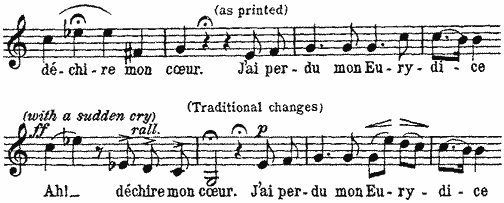
[Listen]
The change on the third repetition of the principal theme is quite in
accordance with the license then accorded in such airs.
In a special version of the opera Armide (Gluck), revised and edited by the late Sir Charles Hallé, the first bars of the great air of Armide in the first scene of the fourth act, “Ah! si la liberté” (Ah! if my liberty must from me then be taken), are printed thus:

[Listen]
The situation is where Armide perceives the knight Renaud in the
gardens of her enchanted palace, whither he has come to destroy the
sorceress on account of her magic arts. Although the enchantress knows
that the[Pg 75] mission of the knight is to deprive her of liberty, she
herself succumbs to the fatal passion of love. I have briefly
described the scene in order that my meaning may be clear. In the
second half of the first bar, the acciaccatura was never intended by
the composer to be actually sung as printed. It was his only way of
indicating the sob or sigh whereby Armide finishes her exclamation,
“Ah!” The effect is called “the Dramatic sob,” and is known to every
opera-singer. Here is the composer’s meaning, as far as it is possible
to convey it in writing:

[Listen]
(A portamento must be made from the first note to the next, when the
breath must be taken quickly to give the idea of a sob or sigh.)
Again, in a recent edition of the same air by the distinguished composer Vincent d’Indy (Nouvelle Édition Française de Musique Classique), occurs the following:
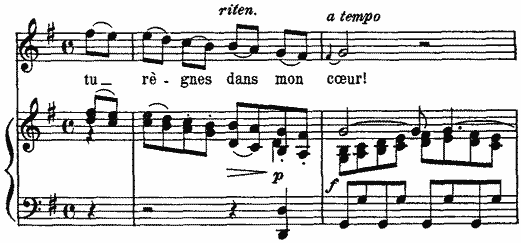
[Listen]
The effect of the F sharp in the last bar, if sung against the
harmony given, in which the preceding chord is resolved, would be
intolerable. Surely, the composer intended a pronounced rallentando
on the latter half of the bar, and a carrying of the voice by a
portamento to the last note. Thus:

[Listen]
In the edition of the immortal air in the opera of Xerxes,
universally known as the “Largo of Handel,” also revised and edited by
d’Indy, may be noticed the following:
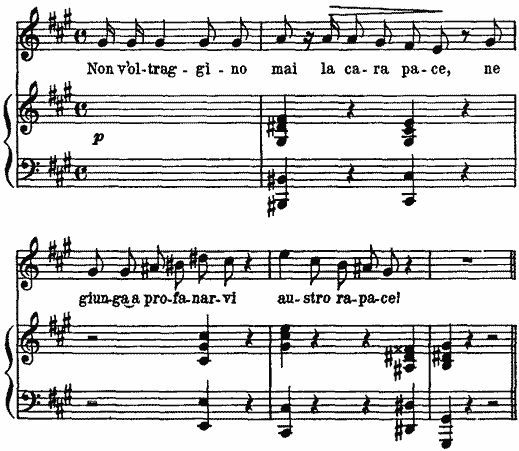
[Listen]
Of course, every operatic conductor knows that the chord in the
orchestra must be played “after the voice,” as the technical phrase
has it. But not every pianist or organist is familiar with this usage,
and the effect would be very disagreeable if given as written. It
should be performed thus:
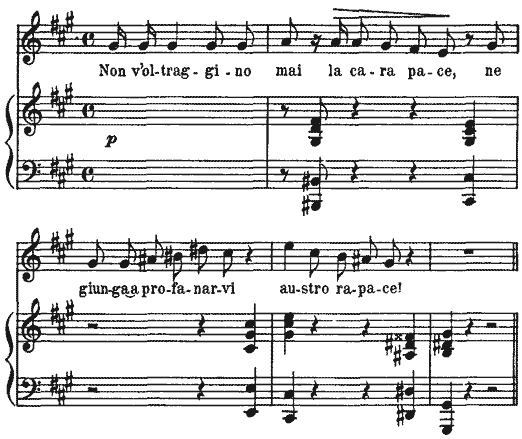
[Listen]
Besides, why claim that a certain edition is “revised and edited,”
when all the care and musical knowledge seem to have been expended on
the harmonies only? Surely, the voice-part in these classics is not
without its need of elucidation.
An edition of The Messiah, revised for performance,[Pg 78] can scarcely be called accurate when such defects as the following occur:
“And they![]() —
’ were sore afraid.”
—
’ were sore afraid.”
The following is the authentic mode of performing the phrase:
“And ——![]() ’
they were sore afraid.”
’
they were sore afraid.”![]()
In the same edition for the solo singers occurs: (“Behold and see”):

[Listen]
But by a slight syllabic rearrangement, the disagreeable accent on the
last syllable of “un-to” is avoided, and the accent placed on the
word “His,” to which it belongs, while the composer’s music remains
untouched.

[Listen]
Again, in the same air occurs:
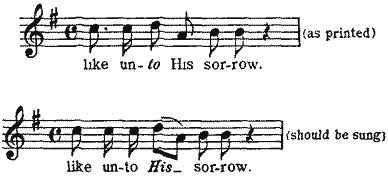
[Listen]
While recognizing the benefits conferred by some of these specially
prepared editions, there remains still more to be accomplished in this
direction before the work is complete. A flood of light has been
thrown on the dark and nebulous places of the instrumental classics by
various distinguished and highly competent musicians. It is sincerely
to be hoped, in the interests of this branch of the æsthetics of vocal
art, that those competent to speak with authority will do so, in order
that in this direction also “the crooked shall be made straight, and
the rough places plain.”
I admit that this question of revising the composer’s written text is an exceedingly delicate and difficult one. It should be attempted only by those possessed of the requisite authority, those who combine tact and taste with judgment and experience. To these qualities should be added a sincere and reverential desire to place in the highest relief the meaning of both poet and composer.
I have said that the license formerly accorded by composers to singers—particularly operatic singers—manifested itself in a twofold form. The second of these phases was the introduction in the body of a theme or melody, and also at its close, of embellishments. Sometimes the composer briefly sketched these ornaments; at other times their places only were indicated. The ornaments in the body of an air are known as abbellimenti or fioriture; those at its close, as cadenze.[Pg 80]
Here is an example of the former, taken from the duet in Elisa e Claudio by Mercadante:

[Listen]
The following is the same passage ornamented:

[Listen]
(As sung by Mme. Malibran. Quoted from “Mécanisme des Traits,” by de
La Madelaine, 1868.)
The rôle of Rosina in Rossini’s Il Barbiere has long been a favourite peg with prime donne on which to hang interpolated ornaments for the display of their vocal agility. Some of these are not always in good taste, being trivial or banal in character, thus concealing the natural charm of the original melody under a species of Henri Herz variations. Others, however, such as those used by the Patti and the Sembrich, for instance, are of great originality and excellent effect.
Here are some of the traditional ornaments and[Pg 81] cadenzas sung by certain famous singers of the past in Rosina’s entrance cavatina: “Una voce poco fa.” This air was originally written by Rossini in E major, the part of Rosina being intended for a mezzo-soprano, and was thus sung by the late Paulina Viardot-Garcia. This exceptionally gifted artist, possessing a voice of very great compass, was enabled to sing not only the rôles assigned to mezzo-soprano contraltos, such as Orphée, or Fidès (Le Prophète), which she created, but also the parts given to dramatic sopranos. Mme. Viardot was thus able, with some slight modifications, to sing Norma, Desdemona (Otello: Rossini), Rachel (La Juive), etc.
The rôle of Rosina has now definitely passed into the possession of florid or coloratura sopranos; much, therefore, of the music is of necessity transposed, the air in question being now sung one half-tone higher, in the key of F.
Here is a change used by Mme. Cinti-Damoreau, who sang the music in the original key. The composer wrote:

[Listen]
Mme. Cinti-Damoreau sang thus:

[Listen]
In the same bar Mlle. Henrietta Sontag, who sang the air a semitone
higher, introduced the following:
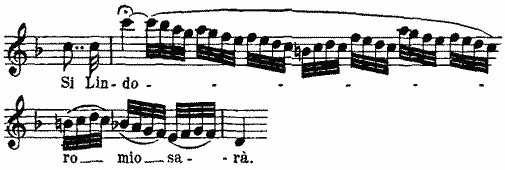
[Listen]
Rossini wrote no cadenza to the air:

[Listen]
Cadenza of Mlle. Sontag:
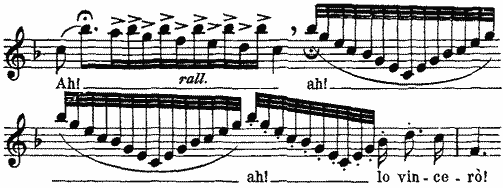
[Listen]
I have already spoken of the bad taste exhibited by some mediocre
singers in covering a coloratura air with so many roulades, etc., as
to render it barely recognizable. It was after hearing one of his own
arias overloaded and disfigured in this manner that Rossini, who was
noted for his biting wit and stinging sarcasms, is said to have
remarked: “What charming music! Whom is it by?”[Pg 83]
Bellini, Donizetti, and composers of their school, sometimes did little more than hand over to the singer engaged to create their works a rough sketch, as it were, which the artists were supposed to fill in and perfect. Singers were expected to add such fioriture, or “flowers,” as would best display their salient points of style and individual characteristics. The Cavatina, or slow movement of the aria, was the medium which called for the qualities of expressive singing, while the Cabaletta was a vehicle for the display of virtuosity and technical mastery. In this latter movement, the equivalent of the Rondo in instrumental music, the performer was left perfectly free to use such embellishments as set forth his own gifts to the greatest advantage. Some singers excelled in bold and rapid flights of scales, chromatic and diatonic; others, in the neat and clean-cut execution of involved traits or figures. It must be remembered, that the great singers of the past were perfectly competent to add these ornaments themselves, as they possessed a complete and sound musical education.
More: sometimes these singers even collaborated with the composers. Crescentini, the last famous male sopranist, is reputed by history or legend—the two are not infrequently synonymous—to have been himself the composer of the well-known aria “Ombra adorata,” introduced by him in Zingarelli’s opera Romeo e Giulietta, as also of the prayer sung by Romeo in the same work. His singing of it is said to have moved his audience to tears, and gained for him the decoration of the Iron Crown, conferred upon him by Napoleon I. The Em[Pg 84]peror also induced him, by the offer of a large salary, to settle in Paris as professor of singing.
When these great artists—their career as public singers being ended—began in turn to form pupils, they were admirably fitted for the task of imparting instruction, being excellent musicians, and, as I have said, composers of no insignificant merit. They had a sound theoretical knowledge, compared with which that of many of our modern singers seems but a pale and feeble reflection.
The collaboration of composer and interpreter is not altogether unknown in the domain of instrumental music. Is it not historical that Mendelssohn profited largely from the wise counsels of the celebrated violinist Ferdinand David in the composition of his concerto for violin and orchestra? This does not mean that David contributed any musical phrases or ideas to the work; but that his practical knowledge of the special characteristics and capabilities of the solo instrument enabled him to suggest how the composer’s thoughts might be most fittingly presented.
Returning to the question of the introduction of ornaments, etc., into a composer’s work, the following extract may be of interest to the musical student. It is from a volume of criticism, now out of print, a copy of which is possessed by the present writer. The article appeared in La Patrie more than forty years ago, and was called forth by the ornaments written by the then well-known singer and teacher of great ability, Stéphan de La Madelaine. These changes were for the great[Pg 85] air of Agathe in the second act of Der Freischütz, and were the cause of much discussion among the music-critics of the time.
“Following the example of celebrated vocal virtuosi whom he had formerly known, and availing himself of the license then permitted, the master (de La Madelaine) has introduced several alterations (changements). These, however, in no sense clash with the original character of the air itself.
“That the introduction of such ornaments has caused an outcry, is not surprising. We should remember, however, that the Freischütz was written at a period when, in certain places, the composer left the field entirely open to the singer, permitted him to make such changes as he might deem necessary. It must not be thought that in so doing the interpreter corrects the composer: he simply seeks to express, to the utmost of his abilities, the intention of the author.
“The operas of Bellini, of Rossini, and, in general, of all the Italian masters, are full of these intentional gaps (lacunes) which were filled in by the singers. Nay, in the earliest days of the Neapolitan school, still greater liberty was allowed; the recitatives were all improvised by the executants, and were not even noted down. Each singer made his own, which the maestro al cembalo accompanied with a few simple chords.
“In the cavatina in Norma, each cantatrice introduces her own changes on the recurrence of the principal theme, and the public applauds. Why then this outcry against the same procedure in Der Freischütz?[Pg 86]
“That this custom or practice might lead to great abuse and that it is necessary to uproot it gradually, is our opinion. But this radical reform can be realized only in forthcoming works; those of the ancient school ought to be interpreted by following the conventions which the composer himself has respected.
“That the changements written by M. de La Madelaine for the air of the Freischütz are permissible, is proved by the fact that Weber himself has sanctioned and approved them, as, if need be, a great number of contemporaries can attest.” (Franck-Marie.)
Whoever has had the good fortune to hear Mme. Marcella Sembrich in the rôle of Amina, in Bellini’s La Sonnambula, will have heard an excellent example of remarkable technical skill or virtuosity, with irreproachable taste regulating its display. The ornaments and changes used by her in the rondo finale, “Ah, non giunge,” are models of their genre. What else could be expected of an artist so gifted as to be able to perform the lesson-scene in Rossini’s Il Barbiere (introducing therein the air with variations by Proch) in Italian; and in the course of the same scene sing, in German, “Ich liebe dich,” by Grieg, and play the Andante and Rondo Russe, for violin, by de Bériot, and a valse by Chopin on the piano?
The opera, La Sonnambula, requires much rearrangement both of the music and of the verbal text, to which it is badly fitted. The greater part of the music written for Elvino has to be transposed, mostly a third lower, in order to make it practicable under existing conditions.[Pg 87]
No effect whatever could be made were a cantatrice to follow implicitly the written notes of this opera, such being merely a rough sketch, as it were, of the composer’s ideas, which the singer is supposed to complete. Several instances from the andante “Ah! non credea mirarti,” will suffice to prove this. The following is the printed version.
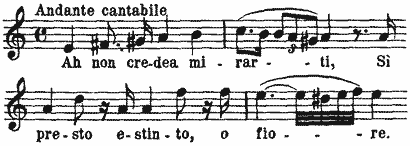
[Listen]
This is but a suggestion of the composer’s idea. The artist will
therefore not follow too closely the printed version; but following
the evident indications for a pathetic and expressive cantabile will
perform it thus:
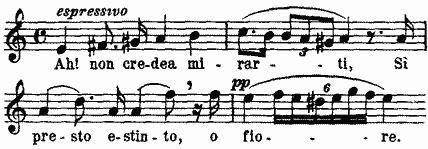
[Listen]
Again a brief outline, as printed:
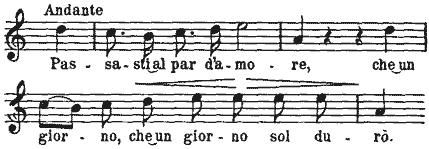
[Listen]
which, if sung as follows, fills in the details:
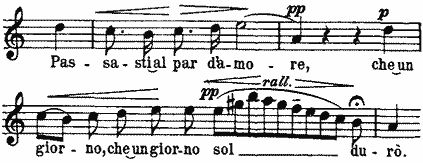
[Listen]
Also the passage in the same aria, where Amina sobs as she slowly lets
fall to the ground the blossoms given her in the first act by Elvino,
requires an entire rearrangement of the syllables to bring out the
composer’s meaning.

[Listen]
Let any one go over this passage carefully, and he will be convinced
that it is, as I have said, merely a sketch of the composer’s idea. As
it stands in the published version it is impossible of execution, and
if it were possible, would be devoid of all effect: the syllables
being wrongly placed, no opportunity for breathing is given the
singer, and the final cadenza is marred by being allotted to the word
“amore.” Here is a revision of the latter, the cadenza being one I
wrote for[Pg 89] a pupil, Mme. Easton-Maclennan, of the Royal Opera, Berlin:
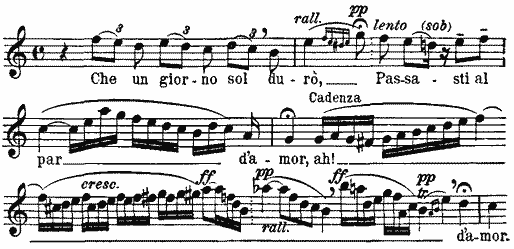
[Listen]
It will thus be seen, from the numerous foregoing examples, that these
ornaments and interpolations are not added from a vulgar idea of
correcting or improving the composer’s music, but are strictly in
accordance with certain conventions thoroughly understood by both
composer and singer. To omit them, or follow too closely the printed
text, would be to ignore the epoch, school and character of the music;
a careful study of which forms one of the cornerstones of
Interpretation. A skilled artist will always strive to analyze and
interpret the intentions of the author. If one to whom is confided the
vocal part of a composer’s work were to limit himself to a
mathematically correct reproduction of the written notes only, instead
of searching below the surface for the author’s meaning, his
performance would merely resemble the accurate execution of a
solfeggio by a conscientious scholar. It would have the same
relation to high artistic effort as the photographic repro[Pg 90]duction of
a landscape bears to the same scene as viewed and transmitted to
canvas by a great painter.
The sincere artist will carefully consider every detail. He will not be content to study his own part only, but will study the orchestral score which accompanies it. He will, in fact, follow the example set by good string-quartet players, who listen attentively to the other instruments during rehearsals, so that the perfect welding together of the different parts may form a homogeneous whole. Such an artist, in complete possession of the mechanical resources of his art, will utilize them all to embody perfectly that which, with the composer, existed only as a mental concept, inadequately transcribed, owing to the limitations of his media—pen, ink and paper.
And it is only when in possession of the authentic traditions of Oratorio and Opera that the singer, such as I have supposed, will be able to vivify these great creations, will be able to invest them with warmth and colour, and thus make clear all their meaning, reveal all their beauty.
ALTHOUGH répertoire forms no integral part of Style, being rather the medium for its practical application, a few words on this important subject may not be out of place. The répertoire necessary for a singer may be divided into two sections, Opera and Concert. The latter includes Oratorio and Cantata.
In spoken Drama, a performer may begin his career by playing the youthful lovers, and end it by impersonating the heavy fathers. He may first sigh as Romeo, and later storm as Capulet. Not so in Opera, or lyric Drama, where the line of work to be followed is determined at the outset by the type of voice possessed by the aspirant, and which line (or emploi, as it is termed) he follows of necessity to the end of his professional career.
I know there are some few instances of artists who, later, have successfully adopted rôles demanding another range than the one needed for their earlier efforts. But it is an open question whether the performer’s instrument really changed. It must either have been wrongly classified at one of the two periods, or the vocal keyboard—so to speak—transposed a little higher or lower. The character of the instrument remains the same; a viola strung as a violin would still retain its viola quality of tone.
The case is different where a soprano who may have[Pg 92] begun by singing the florid rôles of opera, has so gained in volume of voice and breadth of style as to warrant her devoting these acquisitions to characters requiring more dramatic force than was needed, or could be utilized, in coloratura rôles. Mlle. Emma Calvé, Mesdames Lilli Lehmann and Nordica, are notable examples of this. Each of these distinguished artists began her career by singing what are known as “Princess” rôles, before successfully portraying Carmen or the Brünnhildes. As a rule, it is by singing many different rôles that the lyric artist gains the skill and sureness that may ultimately render him famous in a few. Mlle. Grandjean, now principal first dramatic soprano at the Paris Opéra, began her career there—after a few appearances at the Opéra-Comique—by singing the very small part of the nurse Magdalene in Wagner’s Die Meistersinger. Perseverance, if allied to ability, can accomplish much.
When the type of voice and the natural temperament of the singer do not accord—as sometimes happens—he would be unwise not to adhere to the work for which his vocal means, not his preference, are best adapted. To follow the contrary path, and essay rôles requiring for their fitting expression more dramatic fire and intensity than his vocal instrument can supply, would be to shorten his career, owing to the certain deterioration and possible extinction of the voice. There are sufficient voiceless examples to prove, were proof needed, the truth of this assertion; and their atonic condition is due to the cause mentioned.[Pg 93]
The first requisite for the aspirant who wishes to follow the operatic career is undoubtedly a voice possessed of the three essential factors of Quality, Power and Compass; what is termed in Italy a “voce di teatro,” or voice for the theatre.
But an opera-singer is actor as well as singer, and in this direction more—much more—is now demanded of him than formerly. But to those possessed of what is known as the Instinct of the Theatre, or Scenic Instinct, the gestures and attitudes of the operatic stage, being largely conventional, are soon acquired. Scenic accomplishments are undoubtedly necessary to the stage-singer, but his mimetic studies should not preclude him from making himself a thorough master of the vocal side of his art. There is a difference between an actor who sings, and a singer who acts.
Besides the mimetic faculty, certain physical gifts are also needed by the opera-singer, according to the requirements of the line of rôles to which he is inevitably assigned by the nature and type of his particular voice. It is true that stage artifice has now reached great perfection; but it has its limits, and cannot accomplish miracles.
It requires much imagination and great generosity on the part of the public to accept a tenor, whose waist-girth would not unfit him for the part of Sir John Falstaff, as a youthful and romantic Romeo, or a half-starved and emaciated Rodolphe. Illusion is rudely shaken, if not absolutely dispelled, in witnessing a soprano, whose age and embonpoint are fully in evidence, impersonate a[Pg 94] girlish Gilda or a consumptive Traviata. Such discrepancies may be overlooked by the public in the case of old established favourites, but it would be unfortunate for the débutant to commence with these drawbacks. And yet there have been a few famous artists whose extraordinary vocal talent atoned for other very pronounced defects. Such an one was the Pisaroni, a celebrated contralto, said to have been so ill-favoured that she always forwarded her likeness to any opera director to whom she was personally unknown, who offered her an engagement. But so exceptional were her voice and talent, that certain of her contemporary artists have declared that by the time Pisaroni had reached the end of her first phrase, the public was already conquered.
As personal preference is very often mistaken for aptitude or natural fitness, a lyric artist is not always the best judge as to which of the rôles in his répertoire are really fitted to display his abilities to the best advantage. The singer combines in himself both instrument and performer; therefore he rarely, if ever, hears himself quite as does another person. Until possessed of the ripened judgment gained by experience, he would do well to be guided in this matter by one who, to the knowledge required, adds taste and discernment. That a liking or preference is sometimes mistaken for the aptitude and gifts necessary for the successful carrying out of certain work, is too well known to be even questioned. It is the constantly recurring case of the low comedian who wishes to play Hamlet. A young tenor[Pg 95] whose great vocal and physical advantages made him an ideal Duke in Rigoletto, a fascinating Almaviva in Il Barbiere, found but little enjoyment in life because his director refused to allow him to try Otello and Tannhäuser, for which he was vocally unfitted. Never show the public what you cannot do, is the best advice that can be given in such cases. Even the finest and most experienced singers are occasionally liable to make mistakes in the choice of rôles. Madame Patti once sang Carmen, and Madame Melba essayed Brünnhilde; but I am not aware that either of these famous cantatrices repeated the experiment.
For those who intend to follow a concert-singer’s career, there is a vast literature of vocal music specially written for this purpose, from which to select. There are few modern operatic excerpts which do not suffer somewhat by being transplanted from the stage to the concert-platform. In no case is this more clearly proved than in the selections so frequently given from Wagner’s music-dramas. Of course, I am speaking more particularly of those extracts which require the services of a vocalist. Such selections given in the concert-room are in distinct violation of the composer’s own wishes, frequently expressed. Besides lacking the necessary adjuncts of gesture, costume and scenery, the musical conditions of the concert-room are very unfavourable to the unfortunate singer. He has to struggle[Pg 96] to make himself heard above the sonorities of a powerful orchestra generally numbering over a hundred musicians, and placed directly around and behind him, instead of on a lower level, as in the case of a lyric theatre. Besides which, Wagner’s works can now be heard in all large cities under the conditions necessary for their proper presentment, and as intended by their author-composer. Therefore, there is no longer the same reason as may have existed years ago, for the performance of extracts at purely symphonic concerts.
In cases where the singer has to select numbers for a symphonic concert and to be accompanied by an orchestra, there is a mine of wealth, not yet exhausted, in the operas of the older classic composers. These, being less heavily orchestrated than the ultra modern works written for the theatre, do not suffer in the same degree from the different disposition of the orchestral instruments.
There are also a few vocal numbers with orchestral accompaniments written in the form of a “scena,” such as the “Ah, perfido” of Beethoven, and the “Infelice” of Mendelssohn, which might possibly form an agreeable change to the frequenters of symphonic concerts, jaded a little, perhaps, with the oft-repeated “Dich theure Halle” and “Prayer” from Tannhäuser.
In order to render them more in keeping with the conditions of symphonic concerts, orchestral accompaniments, to many songs by the classic composers, have been made by excellent musicians from the original piano-part. The ethical question involved in the presentation of such works in a form other than that written[Pg 97] by the composer, need not be considered here. Each artist must decide the matter for himself.
So far as songs with accompaniments for the piano are concerned, there is a mine practically inexhaustible and from which new treasures are constantly brought to light. For Recital purposes, the choice and sequence of a programme is second in importance only to its execution. And although suppleness and adaptability are valuable, even necessary, qualities, in a concert-singer, he will sometimes find that certain songs—admirable in themselves—are unsuited to him, for reasons which it is not always possible to define. In such cases it is not a matter of compass, or tessitura, of voice, or even temperament; there is some hidden lack of sympathy between the composer and his interpreter. A song should seem like a well-fitting garment; not only admirably made, but specially designed for the person who wears it.
THE art of Singing is at present in a period of transition; and all unsettled conditions are unsatisfactory. Former standards are being thrown down; and the new ones are not yet elected, or, if chosen, not yet firmly fixed in the places of the old.
All Arts have a period in their history when they seem to reach their culminating point of technical perfection. Perhaps this point is reached when the art is practised for its own sake, without giving much consideration or attributing special importance to what it expresses. Sculpture reached its apogee under the Greeks, who, more than any other race, prized Form—particularly as manifested in its highest expression, the human figure. Painting also was at its climax of technical development during the Renaissance, when life was full of movement, and costume picturesque. But at this period in each of the two arts, skill was regarded as of more importance than the subject. In other words, the perfection of the sculptor’s statue or the scene depicted by the painter was of more interest and importance than the object or scene itself. If the work were admirably executed, the story it told had relatively little importance.
Singing, which is speech conveyed through music, similarly reached its highest point of technical excellence[Pg 99] when the voice of the singer was considered as little more than a mechanical instrument; when beauty of tone-quality and perfect virtuosity were the only ends for which to strive. This period was at its height with Farinelli, Caffarelli, Gizziello, and ended perhaps with Crescentini. That these singers possessed extraordinary technical skill, or execution, is amply attested by the exercises and airs, still extant, written for them by Porpora, Hasse, Veracini, and others. That they also had musical sentiment or expression, is authoritatively proved from the emotion caused in their auditors by their performance of a slow movement or cantabile. But it was musical expression only, and as if performed on a solo instrument, as a flute or violin, which does not possess the faculty of uttering words. The operas in which these singers appeared had some plot or story, it is true; but its importance was of the slightest—analogous to, and of the same value as, the subject in painting and sculpture at corresponding periods of their history.
But singing, like these two sister-arts, has passed the period when it was, or could be, appreciated purely for the perfection of its technique. It has developed and broadened in other directions, and more now is demanded of the singer than mere mechanical perfection. Composers—notably Gluck—began to perceive the great possibilities to be attained by the development of the Greek lyric ideal; that is, the presentation of the Poetic idea by, and through the medium of, music; instead of being, as formerly, merely its excuse, a framework for the musician upon which to hang melodies.[Pg 100]
Although Gluck, like all innovators, was considered by his contemporaries as a revolutionary and iconoclast, he only strove to develop and perfect an art that had already existed in a primitive form. This was the art of animating a poetic idea by means of melopœia; which Wagner later developed still further.
Gradually, two essentials of good singing—tone-quality and truth of intonation—began to be neglected. But why should either of these two factors be less essential to a singer than to an instrumentalist?
Of late it has been tacitly assumed, if not boldly claimed, that sentiment, passion, temperament, atoned for—even if they did not entirely replace—voice and lack of skill in the artist. But what constitutes an artist? Art has been defined by an English lexicographer as “Doing something, the power for which is acquired by experience, study or observation;” and an artist, as “One skilled in the practice of any art.” The French writer d’Alembert says, “L’art s’acquiert par l’étude et l’exercice” (Art is acquired by study and practice). If these definitions of art be accepted, its external expression or manifestation is essential through some vehicle or medium, otherwise there is neither art nor artist. Concepts or ideals have their genesis in mind, but were they to remain there, the poet, painter, sculptor or musician (composer or interpreter) would have no right to the title of artist, because his concepts remained in thought-form only, and unexpressed.[Pg 101] Therefore, as a composer can be accepted as artist only when he has given that to the world which entitles him to the distinction, how can his so-called interpreter be considered an artist when, through insufficiency of technical ability, he is unable to present satisfactorily the author’s concept? No matter in what abundant measure such a performer may possess the good qualities of earnestness, conviction and sincerity, he is not an artist. “Poeta nascitur, non fit,” has long been accepted as a truism; and similarly, it is supposed that the artist also is born, not made. But seeing that the mechanical side of any art is learned by experience, study, or observation—still to quote the definition—without which an adequate manifestation of that art is impossible, then certainly the artist is made. He is born with certain qualities necessary for the artist, it is true; but failing his technical skill, these other gifts can never be fully utilized.
It is to be deplored that the studies of many vocal aspirants are not conducted on the same plan that is followed by those who desire to attain perfection on a musical instrument. These acquire a technique, and learn or study many works which may broaden or perfect their style, before commencing to prepare a répertoire. The opposite course is followed by many students of singing, who study rôles, instead of learning first how to sing. The full meaning of the highest examples of the modern lyric drama can be made apparent only by those who have fully mastered the vocal, as well as the mimetic, side of lyric art. Too much[Pg 102] importance is, in my opinion, attached to the latter branch, at the cost of the former. I repeat, an opera-singer should be a singer who acts, not an actor who sings.
On the occasion of the bestowal of awards at the Paris Conservatoire in August, 1905, M. Dujardin-Beaumetz, Under-Secretary for the Fine Arts, in his address to the students made pointed allusion to the difference of results between the instrumental classes and those for singing. Said the orator: “It is claimed that singing is in a state of decadence, and that the cause is largely due to the style of modern music. It is rather owing to the fact that this art is not studied at present with the same methodic diligence that formerly obtained. I would remind the students of singing that they gain nothing by neglecting the earlier studies, and that their professional future would be better assured if it rested on a solid basis of vocal technique. It is, therefore, in their interest that, with a view to assure this important point, certain reforms will be instituted.”[6]
The professors of the classes for singing were also advised to draw more on the great classic writers for the voice, instead of confining themselves principally to the operatic répertoire.[Pg 103]
Every art reaches its apex of perfection, and then seems to decline; it may even temporarily disappear. But, being immortal, it is never lost. It finds other modes of manifestation, and reappears in other forms. The principles on which it is founded do not change; but constantly changing conditions necessitate a new application of these principles. This necessity was acknowledged for poetry itself by André Chénier:
“Sur des pensées nouveaux, faisons des vers antiques.” (Let us embody modern thoughts in classic verse.)
Music follows the great laws of development to which all things are subject. It would be foolish, nay, impossible, to try to resuscitate an old form of art. Foolish, because the art itself would have lost all except its archaic charm or interest; impossible, because conditions have so completely changed that the attempt would be merely the galvanizing of a corpse, not its reanimation.
Similarly, the art of singing can be successful only in proportion as it recognizes the existence of other conditions. These it meets by observing the old principles, but changing their mode of application.
The education of the singer of to-day requires to be conducted on broader and more comprehensive lines than in the past, on account of the different conditions which have presented themselves. Singing—that is, the alliance and utterance of Music and Poetry—is one of the highest manifestations of the Beautiful, and is man’s supreme and greatest creation. Therefore, singing will not seek in future to rival a mechanical instru[Pg 104]ment. It will, it is evident, give to the poetic idea a prominent, though not a predominant, place. But this poetic idea can be revealed to the listener only by a singer who is master of all the technical phases of his art. These component parts of his vocal education must of necessity comprise—as was laid down in the opening chapter of this work—Pose of Voice, Technique, Style, and Répertoire.
It has been demonstrated that the first of these elements is essential, because the other stones of the complete structure cannot be successfully laid on an insecure foundation. The singer must have the second, or he will be unable to materialize his concept, like an unskilled carver who possesses the necessary material and tools, but lacks the technical ability to utilize either. He must possess Colour, whereby his vocal palette is set with the varied tints necessary for the different sentiments to be expressed; Accent, so that character may be given to the music and appropriate emphasis to the text; and Phrasing, in order that he may punctuate the music effectively and the words intelligently.
Perfect master of these, he is in possession of all that goes to make up Style. And, if these premises be accepted, it must be evident that he is in possession of the qualities that were necessary to make singers great in the past, and are indispensable to make them great in the future.
[1] These admirably expressed views illustrate and exemplify the principles I laid down in a conférence (Paris, 1902) on Voice-Production (Pose de la Voix), wherein I demonstrated the possibility of acquiring, by the aid of the resonating cavities, a greater sonority, more in conformity with the demands and necessities of present-day music.
[2] Sir George Grove, in the “Dictionary of Music and Musicians,” P. 611, says that the French text is by Molière! This is a self-evident error.
[3] See very interesting article signed C. Saint-Saëns in the Écho de Paris for July 23, 1911.
[4] See Écho de Paris, op. cit.
[5] Cases are numerous of changes made by composers even after their work has been produced. The Fountain Scene in Lucia was entirely remodelled by Donizetti, some time after its original production at Milan, the first setting being replaced by the “Regnava nel silenzio” now used, written for Persiani when the opera was first given at the San Carlo, Naples.
[6] One of these reforms was that the first year’s study is to be devoted entirely to tone-formation; no attention being paid to the employment of the tones in melody. Nor are the professors of singing at the Conservatoire now selected—as was formerly the case—exclusively from among ex-opera-singers.
End of the Project Gutenberg EBook of Style in Singing, by W. E. Haslam
*** END OF THIS PROJECT GUTENBERG EBOOK STYLE IN SINGING ***
***** This file should be named 21400-h.htm or 21400-h.zip *****
This and all associated files of various formats will be found in:
http://www.gutenberg.org/2/1/4/0/21400/
Produced by David Newman, Chuck Greif, Linda Cantoni, and
the Online Distributed Proofreading Team at
http://www.pgdp.net
Updated editions will replace the previous one--the old editions
will be renamed.
Creating the works from public domain print editions means that no
one owns a United States copyright in these works, so the Foundation
(and you!) can copy and distribute it in the United States without
permission and without paying copyright royalties. Special rules,
set forth in the General Terms of Use part of this license, apply to
copying and distributing Project Gutenberg-tm electronic works to
protect the PROJECT GUTENBERG-tm concept and trademark. Project
Gutenberg is a registered trademark, and may not be used if you
charge for the eBooks, unless you receive specific permission. If you
do not charge anything for copies of this eBook, complying with the
rules is very easy. You may use this eBook for nearly any purpose
such as creation of derivative works, reports, performances and
research. They may be modified and printed and given away--you may do
practically ANYTHING with public domain eBooks. Redistribution is
subject to the trademark license, especially commercial
redistribution.
*** START: FULL LICENSE ***
THE FULL PROJECT GUTENBERG LICENSE
PLEASE READ THIS BEFORE YOU DISTRIBUTE OR USE THIS WORK
To protect the Project Gutenberg-tm mission of promoting the free
distribution of electronic works, by using or distributing this work
(or any other work associated in any way with the phrase "Project
Gutenberg"), you agree to comply with all the terms of the Full Project
Gutenberg-tm License (available with this file or online at
http://gutenberg.org/license).
Section 1. General Terms of Use and Redistributing Project Gutenberg-tm
electronic works
1.A. By reading or using any part of this Project Gutenberg-tm
electronic work, you indicate that you have read, understand, agree to
and accept all the terms of this license and intellectual property
(trademark/copyright) agreement. If you do not agree to abide by all
the terms of this agreement, you must cease using and return or destroy
all copies of Project Gutenberg-tm electronic works in your possession.
If you paid a fee for obtaining a copy of or access to a Project
Gutenberg-tm electronic work and you do not agree to be bound by the
terms of this agreement, you may obtain a refund from the person or
entity to whom you paid the fee as set forth in paragraph 1.E.8.
1.B. "Project Gutenberg" is a registered trademark. It may only be
used on or associated in any way with an electronic work by people who
agree to be bound by the terms of this agreement. There are a few
things that you can do with most Project Gutenberg-tm electronic works
even without complying with the full terms of this agreement. See
paragraph 1.C below. There are a lot of things you can do with Project
Gutenberg-tm electronic works if you follow the terms of this agreement
and help preserve free future access to Project Gutenberg-tm electronic
works. See paragraph 1.E below.
1.C. The Project Gutenberg Literary Archive Foundation ("the Foundation"
or PGLAF), owns a compilation copyright in the collection of Project
Gutenberg-tm electronic works. Nearly all the individual works in the
collection are in the public domain in the United States. If an
individual work is in the public domain in the United States and you are
located in the United States, we do not claim a right to prevent you from
copying, distributing, performing, displaying or creating derivative
works based on the work as long as all references to Project Gutenberg
are removed. Of course, we hope that you will support the Project
Gutenberg-tm mission of promoting free access to electronic works by
freely sharing Project Gutenberg-tm works in compliance with the terms of
this agreement for keeping the Project Gutenberg-tm name associated with
the work. You can easily comply with the terms of this agreement by
keeping this work in the same format with its attached full Project
Gutenberg-tm License when you share it without charge with others.
1.D. The copyright laws of the place where you are located also govern
what you can do with this work. Copyright laws in most countries are in
a constant state of change. If you are outside the United States, check
the laws of your country in addition to the terms of this agreement
before downloading, copying, displaying, performing, distributing or
creating derivative works based on this work or any other Project
Gutenberg-tm work. The Foundation makes no representations concerning
the copyright status of any work in any country outside the United
States.
1.E. Unless you have removed all references to Project Gutenberg:
1.E.1. The following sentence, with active links to, or other immediate
access to, the full Project Gutenberg-tm License must appear prominently
whenever any copy of a Project Gutenberg-tm work (any work on which the
phrase "Project Gutenberg" appears, or with which the phrase "Project
Gutenberg" is associated) is accessed, displayed, performed, viewed,
copied or distributed:
This eBook is for the use of anyone anywhere at no cost and with
almost no restrictions whatsoever. You may copy it, give it away or
re-use it under the terms of the Project Gutenberg License included
with this eBook or online at www.gutenberg.org
1.E.2. If an individual Project Gutenberg-tm electronic work is derived
from the public domain (does not contain a notice indicating that it is
posted with permission of the copyright holder), the work can be copied
and distributed to anyone in the United States without paying any fees
or charges. If you are redistributing or providing access to a work
with the phrase "Project Gutenberg" associated with or appearing on the
work, you must comply either with the requirements of paragraphs 1.E.1
through 1.E.7 or obtain permission for the use of the work and the
Project Gutenberg-tm trademark as set forth in paragraphs 1.E.8 or
1.E.9.
1.E.3. If an individual Project Gutenberg-tm electronic work is posted
with the permission of the copyright holder, your use and distribution
must comply with both paragraphs 1.E.1 through 1.E.7 and any additional
terms imposed by the copyright holder. Additional terms will be linked
to the Project Gutenberg-tm License for all works posted with the
permission of the copyright holder found at the beginning of this work.
1.E.4. Do not unlink or detach or remove the full Project Gutenberg-tm
License terms from this work, or any files containing a part of this
work or any other work associated with Project Gutenberg-tm.
1.E.5. Do not copy, display, perform, distribute or redistribute this
electronic work, or any part of this electronic work, without
prominently displaying the sentence set forth in paragraph 1.E.1 with
active links or immediate access to the full terms of the Project
Gutenberg-tm License.
1.E.6. You may convert to and distribute this work in any binary,
compressed, marked up, nonproprietary or proprietary form, including any
word processing or hypertext form. However, if you provide access to or
distribute copies of a Project Gutenberg-tm work in a format other than
"Plain Vanilla ASCII" or other format used in the official version
posted on the official Project Gutenberg-tm web site (www.gutenberg.org),
you must, at no additional cost, fee or expense to the user, provide a
copy, a means of exporting a copy, or a means of obtaining a copy upon
request, of the work in its original "Plain Vanilla ASCII" or other
form. Any alternate format must include the full Project Gutenberg-tm
License as specified in paragraph 1.E.1.
1.E.7. Do not charge a fee for access to, viewing, displaying,
performing, copying or distributing any Project Gutenberg-tm works
unless you comply with paragraph 1.E.8 or 1.E.9.
1.E.8. You may charge a reasonable fee for copies of or providing
access to or distributing Project Gutenberg-tm electronic works provided
that
- You pay a royalty fee of 20% of the gross profits you derive from
the use of Project Gutenberg-tm works calculated using the method
you already use to calculate your applicable taxes. The fee is
owed to the owner of the Project Gutenberg-tm trademark, but he
has agreed to donate royalties under this paragraph to the
Project Gutenberg Literary Archive Foundation. Royalty payments
must be paid within 60 days following each date on which you
prepare (or are legally required to prepare) your periodic tax
returns. Royalty payments should be clearly marked as such and
sent to the Project Gutenberg Literary Archive Foundation at the
address specified in Section 4, "Information about donations to
the Project Gutenberg Literary Archive Foundation."
- You provide a full refund of any money paid by a user who notifies
you in writing (or by e-mail) within 30 days of receipt that s/he
does not agree to the terms of the full Project Gutenberg-tm
License. You must require such a user to return or
destroy all copies of the works possessed in a physical medium
and discontinue all use of and all access to other copies of
Project Gutenberg-tm works.
- You provide, in accordance with paragraph 1.F.3, a full refund of any
money paid for a work or a replacement copy, if a defect in the
electronic work is discovered and reported to you within 90 days
of receipt of the work.
- You comply with all other terms of this agreement for free
distribution of Project Gutenberg-tm works.
1.E.9. If you wish to charge a fee or distribute a Project Gutenberg-tm
electronic work or group of works on different terms than are set
forth in this agreement, you must obtain permission in writing from
both the Project Gutenberg Literary Archive Foundation and Michael
Hart, the owner of the Project Gutenberg-tm trademark. Contact the
Foundation as set forth in Section 3 below.
1.F.
1.F.1. Project Gutenberg volunteers and employees expend considerable
effort to identify, do copyright research on, transcribe and proofread
public domain works in creating the Project Gutenberg-tm
collection. Despite these efforts, Project Gutenberg-tm electronic
works, and the medium on which they may be stored, may contain
"Defects," such as, but not limited to, incomplete, inaccurate or
corrupt data, transcription errors, a copyright or other intellectual
property infringement, a defective or damaged disk or other medium, a
computer virus, or computer codes that damage or cannot be read by
your equipment.
1.F.2. LIMITED WARRANTY, DISCLAIMER OF DAMAGES - Except for the "Right
of Replacement or Refund" described in paragraph 1.F.3, the Project
Gutenberg Literary Archive Foundation, the owner of the Project
Gutenberg-tm trademark, and any other party distributing a Project
Gutenberg-tm electronic work under this agreement, disclaim all
liability to you for damages, costs and expenses, including legal
fees. YOU AGREE THAT YOU HAVE NO REMEDIES FOR NEGLIGENCE, STRICT
LIABILITY, BREACH OF WARRANTY OR BREACH OF CONTRACT EXCEPT THOSE
PROVIDED IN PARAGRAPH F3. YOU AGREE THAT THE FOUNDATION, THE
TRADEMARK OWNER, AND ANY DISTRIBUTOR UNDER THIS AGREEMENT WILL NOT BE
LIABLE TO YOU FOR ACTUAL, DIRECT, INDIRECT, CONSEQUENTIAL, PUNITIVE OR
INCIDENTAL DAMAGES EVEN IF YOU GIVE NOTICE OF THE POSSIBILITY OF SUCH
DAMAGE.
1.F.3. LIMITED RIGHT OF REPLACEMENT OR REFUND - If you discover a
defect in this electronic work within 90 days of receiving it, you can
receive a refund of the money (if any) you paid for it by sending a
written explanation to the person you received the work from. If you
received the work on a physical medium, you must return the medium with
your written explanation. The person or entity that provided you with
the defective work may elect to provide a replacement copy in lieu of a
refund. If you received the work electronically, the person or entity
providing it to you may choose to give you a second opportunity to
receive the work electronically in lieu of a refund. If the second copy
is also defective, you may demand a refund in writing without further
opportunities to fix the problem.
1.F.4. Except for the limited right of replacement or refund set forth
in paragraph 1.F.3, this work is provided to you 'AS-IS' WITH NO OTHER
WARRANTIES OF ANY KIND, EXPRESS OR IMPLIED, INCLUDING BUT NOT LIMITED TO
WARRANTIES OF MERCHANTIBILITY OR FITNESS FOR ANY PURPOSE.
1.F.5. Some states do not allow disclaimers of certain implied
warranties or the exclusion or limitation of certain types of damages.
If any disclaimer or limitation set forth in this agreement violates the
law of the state applicable to this agreement, the agreement shall be
interpreted to make the maximum disclaimer or limitation permitted by
the applicable state law. The invalidity or unenforceability of any
provision of this agreement shall not void the remaining provisions.
1.F.6. INDEMNITY - You agree to indemnify and hold the Foundation, the
trademark owner, any agent or employee of the Foundation, anyone
providing copies of Project Gutenberg-tm electronic works in accordance
with this agreement, and any volunteers associated with the production,
promotion and distribution of Project Gutenberg-tm electronic works,
harmless from all liability, costs and expenses, including legal fees,
that arise directly or indirectly from any of the following which you do
or cause to occur: (a) distribution of this or any Project Gutenberg-tm
work, (b) alteration, modification, or additions or deletions to any
Project Gutenberg-tm work, and (c) any Defect you cause.
Section 2. Information about the Mission of Project Gutenberg-tm
Project Gutenberg-tm is synonymous with the free distribution of
electronic works in formats readable by the widest variety of computers
including obsolete, old, middle-aged and new computers. It exists
because of the efforts of hundreds of volunteers and donations from
people in all walks of life.
Volunteers and financial support to provide volunteers with the
assistance they need, is critical to reaching Project Gutenberg-tm's
goals and ensuring that the Project Gutenberg-tm collection will
remain freely available for generations to come. In 2001, the Project
Gutenberg Literary Archive Foundation was created to provide a secure
and permanent future for Project Gutenberg-tm and future generations.
To learn more about the Project Gutenberg Literary Archive Foundation
and how your efforts and donations can help, see Sections 3 and 4
and the Foundation web page at http://www.pglaf.org.
Section 3. Information about the Project Gutenberg Literary Archive
Foundation
The Project Gutenberg Literary Archive Foundation is a non profit
501(c)(3) educational corporation organized under the laws of the
state of Mississippi and granted tax exempt status by the Internal
Revenue Service. The Foundation's EIN or federal tax identification
number is 64-6221541. Its 501(c)(3) letter is posted at
http://pglaf.org/fundraising. Contributions to the Project Gutenberg
Literary Archive Foundation are tax deductible to the full extent
permitted by U.S. federal laws and your state's laws.
The Foundation's principal office is located at 4557 Melan Dr. S.
Fairbanks, AK, 99712., but its volunteers and employees are scattered
throughout numerous locations. Its business office is located at
809 North 1500 West, Salt Lake City, UT 84116, (801) 596-1887, email
business@pglaf.org. Email contact links and up to date contact
information can be found at the Foundation's web site and official
page at http://pglaf.org
For additional contact information:
Dr. Gregory B. Newby
Chief Executive and Director
gbnewby@pglaf.org
Section 4. Information about Donations to the Project Gutenberg
Literary Archive Foundation
Project Gutenberg-tm depends upon and cannot survive without wide
spread public support and donations to carry out its mission of
increasing the number of public domain and licensed works that can be
freely distributed in machine readable form accessible by the widest
array of equipment including outdated equipment. Many small donations
($1 to $5,000) are particularly important to maintaining tax exempt
status with the IRS.
The Foundation is committed to complying with the laws regulating
charities and charitable donations in all 50 states of the United
States. Compliance requirements are not uniform and it takes a
considerable effort, much paperwork and many fees to meet and keep up
with these requirements. We do not solicit donations in locations
where we have not received written confirmation of compliance. To
SEND DONATIONS or determine the status of compliance for any
particular state visit http://pglaf.org
While we cannot and do not solicit contributions from states where we
have not met the solicitation requirements, we know of no prohibition
against accepting unsolicited donations from donors in such states who
approach us with offers to donate.
International donations are gratefully accepted, but we cannot make
any statements concerning tax treatment of donations received from
outside the United States. U.S. laws alone swamp our small staff.
Please check the Project Gutenberg Web pages for current donation
methods and addresses. Donations are accepted in a number of other
ways including checks, online payments and credit card donations.
To donate, please visit: http://pglaf.org/donate
Section 5. General Information About Project Gutenberg-tm electronic
works.
Professor Michael S. Hart is the originator of the Project Gutenberg-tm
concept of a library of electronic works that could be freely shared
with anyone. For thirty years, he produced and distributed Project
Gutenberg-tm eBooks with only a loose network of volunteer support.
Project Gutenberg-tm eBooks are often created from several printed
editions, all of which are confirmed as Public Domain in the U.S.
unless a copyright notice is included. Thus, we do not necessarily
keep eBooks in compliance with any particular paper edition.
Most people start at our Web site which has the main PG search facility:
http://www.gutenberg.org
This Web site includes information about Project Gutenberg-tm,
including how to make donations to the Project Gutenberg Literary
Archive Foundation, how to help produce our new eBooks, and how to
subscribe to our email newsletter to hear about new eBooks.